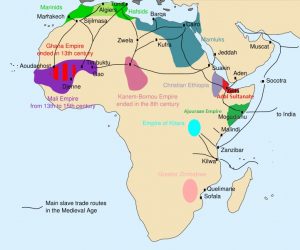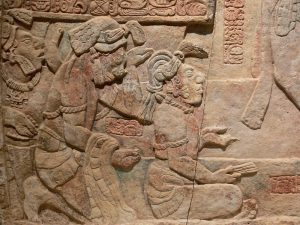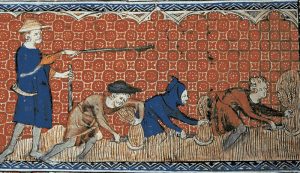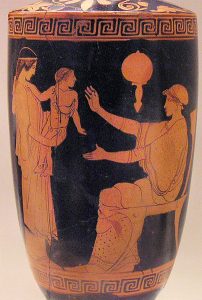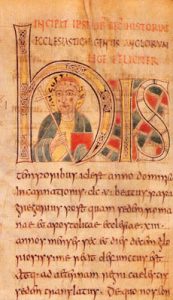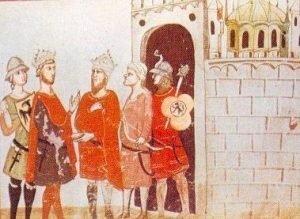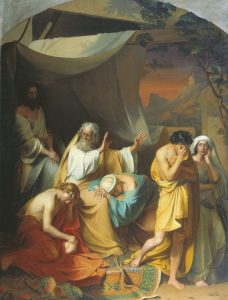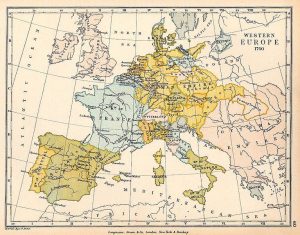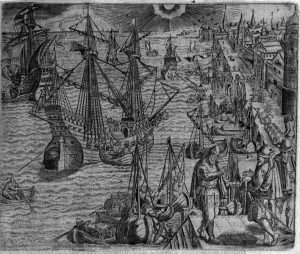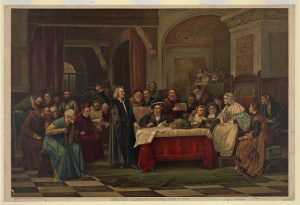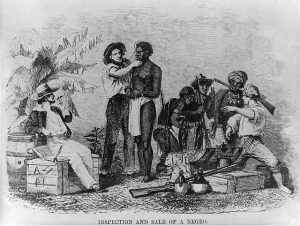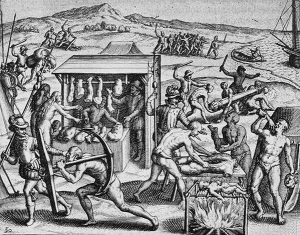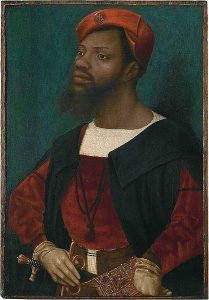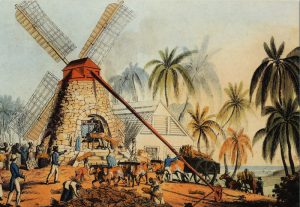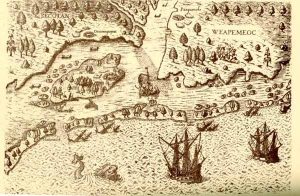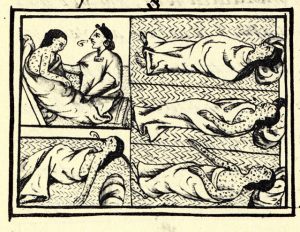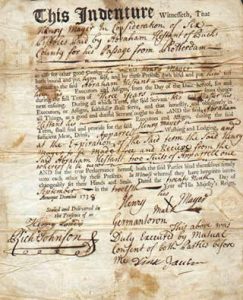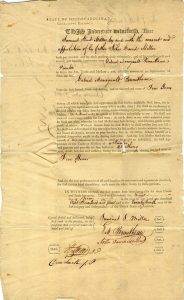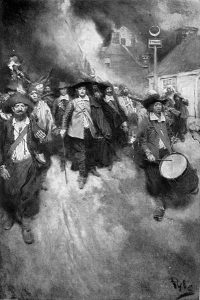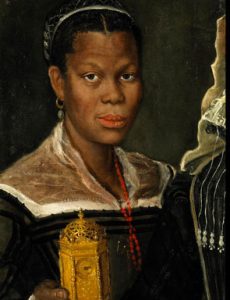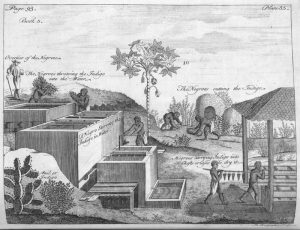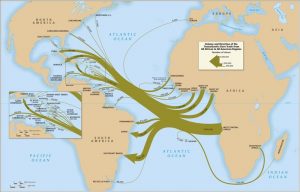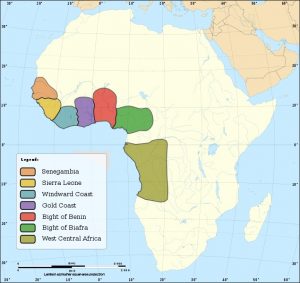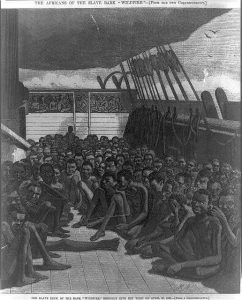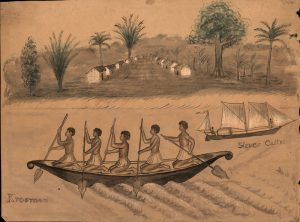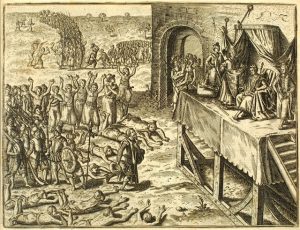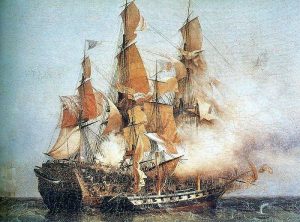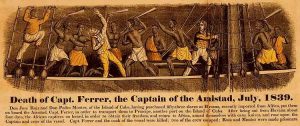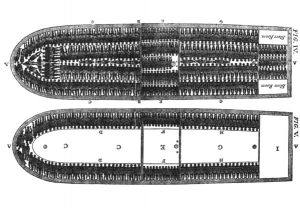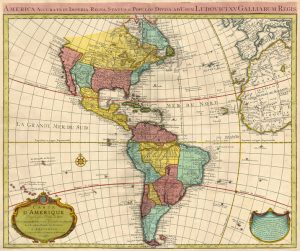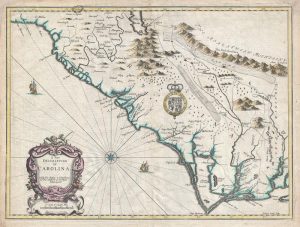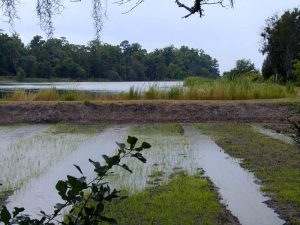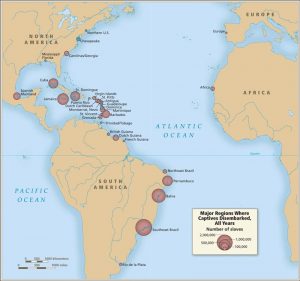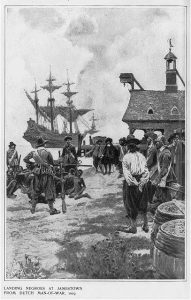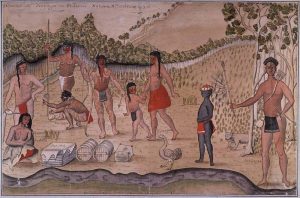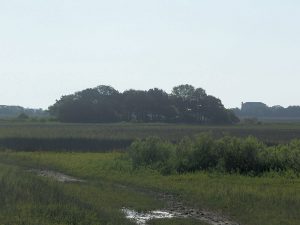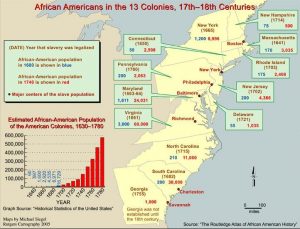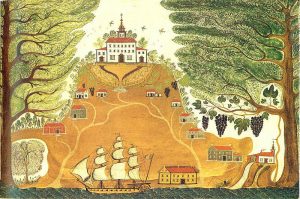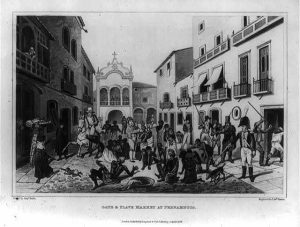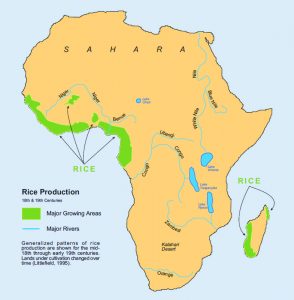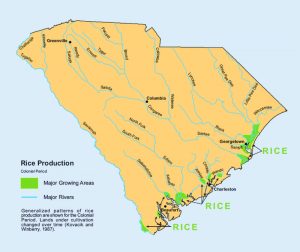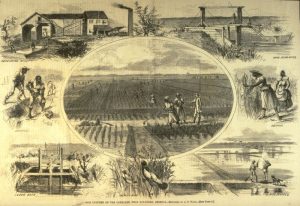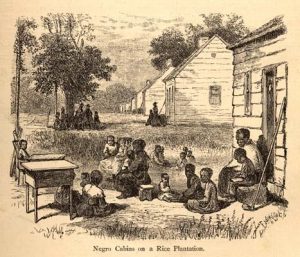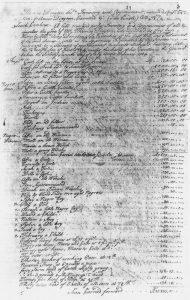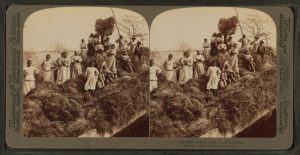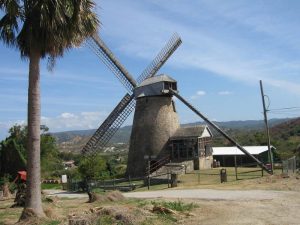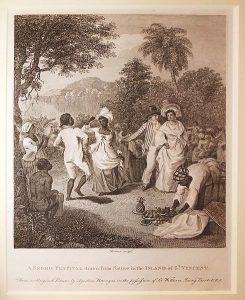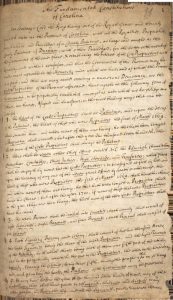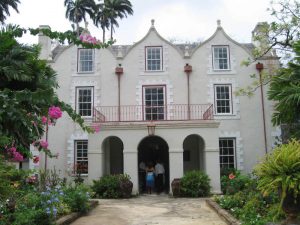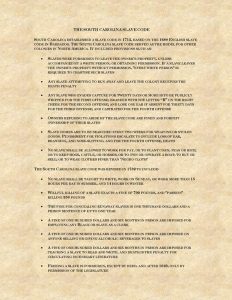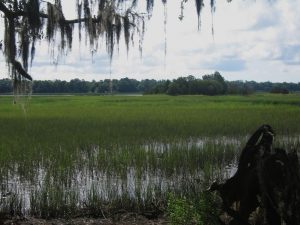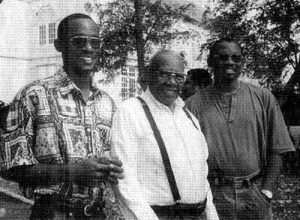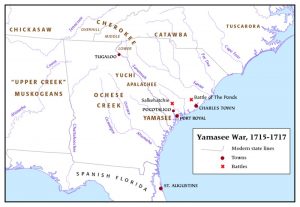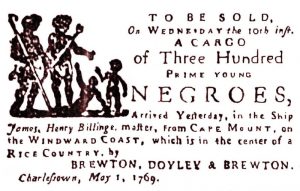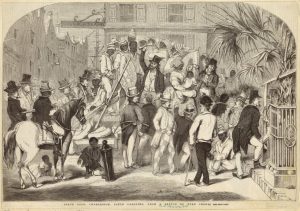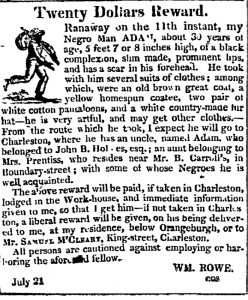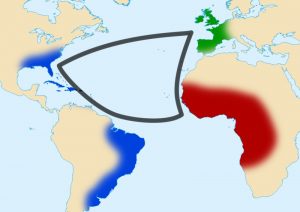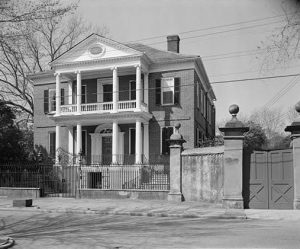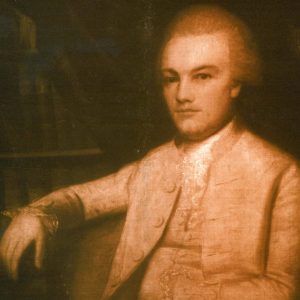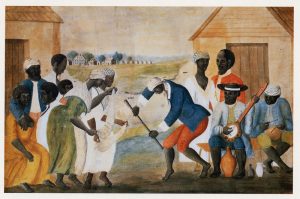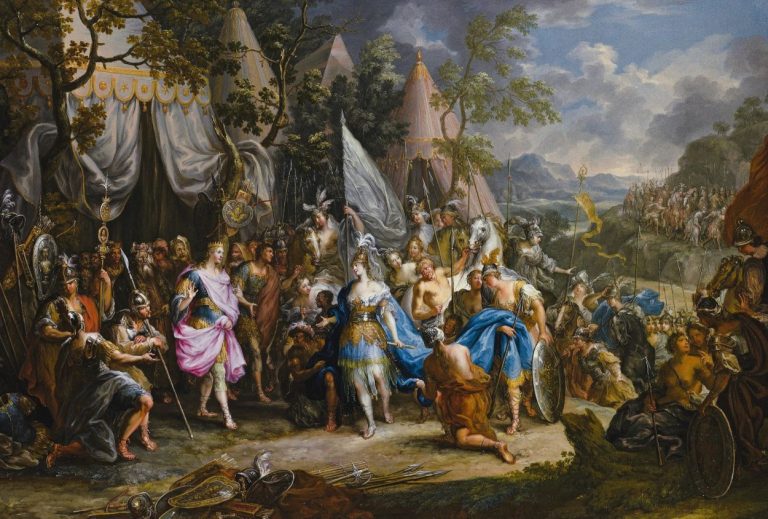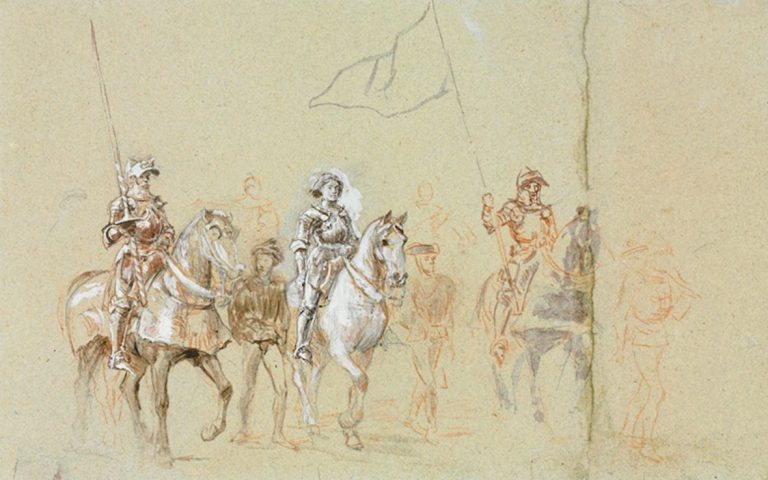Captives being brought on board a slave ship on the West Coast of Africa (Slave Coast), c1880. Although Britain outlawed slavery in 1833 and it was abolished in the USA after the defeat of the Confederacy in the Civil War in 1865, the transatlantic trade in African slaves continued. The main market for the slaves was Brazil, where slavery was not abolished until 1888. (Photo by Ann Ronan Pictures/Print Collector/Getty Images)
By Dr. Mary Battle
Public Historian, Avery Research Center for African American History and Culture
Co-Director of the Lowcountry Digital History Initiative.
College of Charleston
Atlantic World Context
Map of volume and direction of the trans-Atlantic slave trade, Voyages: The Trans-Atlantic Slave Trade Database, courtesy of David Eltis and David Richardson, Atlas of the Transatlantic Slave Trade.
Slavery, plantation agriculture, and the major cash crop of rice all came to Charleston and the surrounding Lowcountry region through a larger Atlantic World trade and migration system. To fully comprehend Charleston’s colonial and antebellum history of slavery, trade, and plantations, we must look beyond the city, region, and even North America, to include the trans-Atlantic exchanges and influences of a complex multicultural and multinational network.
Slave traders in Gorée, Senegal, by Jacques Grasset de Saint-Sauveur, ca. eighteenth century.
Before the fifteenth century, the Atlantic Ocean proved to be a barrier between the populations and cultures of West and Central Africa, Western Europe, and the Americas. Though southern Europeans and northern Africans along the Mediterranean Sea shared a long history of interaction through trade or conflict, African and European maritime trading networks did not extend along the Atlantic coast of Africa into the continent’s western and central regions until the fifteenth century. Ancient overland trade networks between Europe and western and central Africa have a much longer history, but they did not match the volume and speed of later maritime routes. By improving overseas navigation in the fifteenth century, European explorers and entrepreneurs rapidly increased trade and multicultural exchanges with Atlantic African populations ranging from small nations and kinship groups to complex African empires.
The Slave Ship, Slavers throwing overboard the Dead and Dying — Typhoon coming, painting by J.M.W. Turner, 1840, courtesy of the Museum of Fine Arts, Boston, Massachusetts.
By the end of the fifteenth century, European explorers could navigate difficult currents and winds to not only travel down the coast of Africa, but also to cross the Atlantic Ocean to the Americas. Their goal was to find a western trade route to Asia because the growing Ottoman Empire blocked the eastern route. Instead, these explorers encountered the Americas, and in the centuries that followed the Atlantic Ocean transformed from a barrier into a corridor of trade and migration — both voluntary and forced. New trans-Atlantic maritime routes launched an unprecedented level of interaction between Africans, American Indians, and western Europeans.
European and American Indian fur traders in Canada, drawing by William Faden, 1777, courtesy of the Library and Archives Canada.
The numerous encounters, conflicts, and collaborations that resulted from these interactions became known as the Columbian Exchange or the Grand Exchange — a massive movement of animals, plants, human populations, diseases, and ideas that would forever transform the diverse nations and societies of the Atlantic World. While the traditional labor systems, religious beliefs, military rivalries, and social hierarchies of these formerly separate Atlantic World regions remained influential in the New World, each cultural group also underwent dramatic changes in emerging multicultural colonial contexts.
United States Slave Trade, engraving, 1830, courtesy of the Library of Congress.
In the fifteenth century, Europeans seeking economic gain through trade, colonial expansion, mining, and plantation agriculture effectively launched this massive Atlantic World exchange. To make their various economic pursuits in the Americas profitable on growing trans-Atlantic markets, elite and entrepreneurial Europeans required land, widespread trading networks, and significant labor resources. They displaced American Indians from their traditional territories to access new land, and developed labor systems like European indentured servitude and African and American Indian slavery to fill their growing labor needs. For many Africans and American Indians, new encounters with Europeans in the Atlantic World meant conflict and oppression.
Sullivan’s Island, South Carolina, image by Sylvia Frey, ca. 2000s. During the seventeenth, eighteenth, and nineteenth centuries, ships disembarked enslaved Africans on Sullivan’s Island for quarantine in “pest houses,” before they were sold in Charleston markets.
Still, American Indians and Africans proved far from passive in this New World transformation process. In the Americas, Africans and American Indians consistently resisted European-imposed racial hierarchies and enslavement, and carved out spaces for their own political, social, economic, spiritual, and cultural needs and identities. In this way, the diverse cultural groups of the Atlantic World each played significant roles in shaping the multicultural societies that emerged in the coming centuries. Today, the history of the Atlantic World cannot be fully understood without including the multicultural experiences and influences of American Indians, Africans, and Europeans, formed through collaboration and exchange, as well as conflict and oppression, in the New World.
The growth of the trans-Atlantic slave trade and chattel slavery in the Americas, primarily for people of African descent, exemplifies how older labor systems and racial beliefs transformed with New World economic, political, and social developments.
Map of North America, the West Indies, and the Atlantic Ocean, by P. Mortier, 1693.
Slavery before the Trans-Atlantic Trade
Roman collared slaves, marble relief, Smyrna (present day Izmir, Turkey), 200 A.D., courtesy of the Ashmolean Museum.
Various forms of slavery, servitude, or coerced human labor existed throughout the world before the development of the trans-Atlantic slave trade in the sixteenth century. As historian David Eltis explains, “almost all peoples have been both slaves and slaveholders at some point in their histories.” Still, earlier coerced labor systems in the Atlantic World generally differed, in terms of scale, legal status, and racial definitions, from the trans-Atlantic chattel slavery system that developed and shaped New World societies from the sixteenth to the nineteenth centuries.
Slavery in West and Central Africa
Mansa Musa in Catalan Atlas, drawn by Abraham Cresques of Mallorca, 1375, courtesy of the British Library. Mansa Musa was the African ruler of the Mali Empire in the 14th century. When Mansa Musa, a Muslim, took a pilgrimage to Mecca in 1324 he reportedly brought a procession of 60,000 men and 12,000 slaves.
Slavery was prevalent in many West and Central African societies before and during the trans-Atlantic slave trade. When diverse African empires, small to medium-sized nations, or kinship groups came into conflict for various political and economic reasons, individuals from one African group regularly enslaved captives from another group because they viewed them as outsiders. The rulers of these slaveholding societies could then exert power over these captives as prisoners of war for labor needs, to expand their kinship group or nation, influence and disseminate spiritual beliefs, or potentially to trade for economic gain. Though shared African ethnic identities such as Yoruba or Mandinka may have been influential in this context, the concept of a unified black racial identity, or of individual freedoms and labor rights, were not yet meaningful.
Map of Main slave trade routes in Medieval Africa before the development of the trans-Atlantic slave trade, 2012.
West and Central African elites and royalty from slaveholding societies even relied on their kinship group, ranging from family members to slaves, to secure and maintain their wealth and status. By controlling the rights of their kinship group, western and central African elites owned the products of their labor. In contrast, before the trans-Atlantic trade, western European elites focused on owning land as private property to secure their wealth.
Slaves being transported in Africa, engraving from Lehrbuch der Weltgeschichte oder Die Geschichte der Menschheit, a book by William Rednbacher, 1890.
They held rights to the products produced on their land through various labor systems, rather than owning the laborers as chattel property. Land in rural western and central African regions (outside of densely populated or riverine areas) was often open to cultivation, rather than divided into individual landholdings, so controlling labor became a greater priority. The end result in both regional systems was that elites controlled the profits generated from products cultivated through laborers and land. The different emphasis on what or whom they owned to guarantee rights over these profits shaped the role of slavery in these regions before the trans-Atlantic trade.
Cowry shells, photograph, 2005. Cowry shells were often used as currency in different African slave trades.
Scholars also argue that West Africa featured several politically decentralized, or stateless, societies. In such societies the village, or a confederation of villages, was the largest political unit. A range of positions of authority existed within these villages, but no one person or group claimed the positions of ruler or monarchy. According to historian Walter Hawthorne, in this context, government worked through group consensus. In addition, many of these small-scale, decentralized societies rejected slaveholding.
Map of major cultural areas in the Americas before European contact, 2007.
Blue = Arctic
Light Blue = Northwest
Dark Green = Aridoamerica
Orange = Mesoamerica
Light Green = Isthmo-Colombian
Yellow = Caribbean
Red = Amazon
Brown = Andes
Gray = Migratory or Small Farming Societies
As the trans-Atlantic slave trade with Europeans expanded from the sixteenth to nineteenth centuries, however, both non-slaveholding and slaveholding West and Central African societies experienced the pressures of greater slave trade demand. In contrast to the chattel slavery that later developed in the New World, an enslaved person in West and Central Africa lived within a more flexible kinship group system. Anyone considered a slave in this region before the trans-Atlantic trade had a greater chance of becoming “free” within a lifetime; legal rights were generally not defined by racial categories; and an enslaved person was not always permanently separated from biological family networks or familiar home landscapes.
The rise of plantation agriculture as central to Atlantic World economies from the sixteenth to nineteenth centuries led to a generally more extreme system of chattel slavery, where human beings became movable commodities bought and sold in mass numbers across significant geographic distances. New World plantations also generally required greater levels of exertion than earlier labor systems, so that slaveholders could produce a profit within competitive trans-Atlantic markets.
Slavery in the Americas
Pyramid ruins in Yaxzhilan, an ancient Mayan city in Chiapas, Mexico, 2005. Maya was a hierarchical Mesoamerican civilization established ca. 1500-2000 BC. The Mayan social hierarchy included captive or tribute laborers who helped build structures such as pyramids.
In the centuries before the arrival of European explorers, diverse American Indian groups lived in a wide range of social structures. Many of these socio-political structures included different forms of slavery or coerced labor, based on enslaving prisoners of war between conflicting groups, enforcing slavery within the class hierarchy of an empire, or forced tribute payments of goods or labor to demonstrate submission to a leader. However, like West and Central African slavery, American Indian slavery generally functioned within a more fluid kinship system in contrast to what later developed in the New World.
Limestone carving of captives being presented to a Mayan ruler, Usumacinta River Valley, Mexico, ca. A.D. 785, courtesy of Kimbell Art Museum.
Ultimately, the practice of slavery as an oppressive and exploitative labor system was prevalent in both Western Africa and the Americas long before the influence of Europeans. Still, the factors that defined the social, political, and economic purposes and scale of slavery significantly changed, expanded, and intensified with the rise of the trans-Atlantic slave trade and American plantation agriculture launched by European expansion. For these reasons, African and American Indian slavery before the trans-Atlantic trade differed significantly from the chattel slavery systems that would later develop in the Atlantic World.
The Decline of Slavery in Western Europe
Serfs in feudal England, on a calendar page for August, Queen Mary’s Psalter, ca. 1310, courtesy of the British Library Manuscripts Online Catalogue.
In contrast to other Atlantic World regions, slavery was not prevalent in Western Europe in the centuries before the trans-Atlantic slave trade. Instead, labor contracts, convict labor, and serfdom prevailed. This had not always been the case. During the Roman Empire and into the early Middle Ages, enslaved Europeans could be found in every region of this subcontinent. After the Roman Empire collapsed (starting in 400 A.D. in northern Europe), the practice of individual Europeans owning other Europeans as chattel property began to decline.
A Greek slave presents a baby to its mother, vase from Eretria in Ancient Greece, 470-460 B.C., courtesy of the National Archaeological Museum in Athens, Greece.
As described in the following sections, this decline occurred due to unique religious, geographic, and political circumstances in Western Europe. By 1200, chattel slavery had all but disappeared from northwestern Europe. Southern Europeans along the Mediterranean coast continued to purchase slaves from various parts of Eastern Europe, Asia, the Middle East, and Africa. In Lisbon, for example, African slaves comprised one tenth of the population in the 1460s. Overall, however, the slave trade into southern Europe was relatively small compared to what later developed in the New World.
After the fall of the Roman Empire, western European elites began to focus on acquiring and controlling land, and the goods produced on the land they owned, rather than controlling laborers through slavery to accumulate goods. The European labor systems that began to replace slavery should not be confused with modern free labor, but serfdom, convict labor, and contract systems did grant workers access to rights that were denied to slaves. For example, European serfs were bound to work for the lord of a manor, but in return the lord provided protection and land that serfs could farm for their own subsistence. While serfs did not own the land they worked, they could not be sold away from it like chattel slaves. Instead, serfs were bound to whichever lord currently owned the manor. By the fourteenth and fifteenth centuries, serfdom declined in Western Europe due to population changes and economic shifts resulting from the Black Death. Hiring contract laborers became more profitable for landowners in Western Europe and as a result, European laborers gained greater control over their own labor and mobility.
European Christianity and Slavery
St. Augustine of Canterbury from the Saint Petersburg Bede, ca. 731-746 A.D., courtesy of the National Library of Russia. St. Augustine was a Benedictine monk from Rome who was sent on a mission to England in 595 A.D. to convert Anglo-Saxon pagans to Christianity. He became the first Archbishop of Canterbury in 597 A.D.
Before New World expansion, concepts of race and racial hierarchies did not define who could and could not be enslaved in Western Europe. Instead, the spread of Christianity in the Early Middle Ages (from the fifth to tenth centuries) marked the boundaries of slavery throughout Europe. Historian David Brion Davis argues that the Judeo-Christian belief in a monotheistic God who rules over a homogenous group of people generally prevented European Christians from enslaving one another. As more western Europeans converted to Christianity, this unified religious identity enabled the decline of slavery in Europe, but allowed other rigid social and labor hierarchies to remain. By 1500, European Christians believed slavery was a more devastating punishment than execution for criminals and prisoners of war. Still, European Christians did not object to the enslavement of non-Christians, particularly due to ongoing conflicts between Christians and non-Christians within Europe, in the nearby Islamic World, and later in West and Central Africa (which also included Muslim regions) and the Americas.
St. Patrick in stained glass window, image by Andreas F. Borchert, Church of Our Lady, Star of the Sea, and St. Patrick in Goleen, County Cork, Ireland, 2009. According to legend and some document evidence, St.Patrick was born in Roman Britain as a Christian in the late 4th century. When he was sixteen years old he was captured and sent to Ireland as a slave. He escaped back to England, but later became a cleric and returned to Ireland to spread Christianity. By the 7th century, he was the patron saint of Ireland.
In northwestern Europe, non-Christian, or “pagan,” Vikings regularly raided coastal towns for slaves from the fifth to the eleventh centuries. The Norman Conquest of England in 1066 helped protect some areas from these slave raids, but tensions and conflicts continued between Christian and non-Christian Europeans. Even after many Irish Celts converted to Christianity starting in the fifth century, English Christians deemed them inferior, based on the suspicion that their religious practices still contained non-Christian rituals. This sense of Christian superiority helped the English justify Irish colonization in the centuries to come.
The Christian Crusades of the High and Late Middle Ages waged against Islamic kingdoms in the eastern Mediterranean, western Asia, and northern Africa, also helped form a division between Christians and Muslims. The expansion of Islam in the fifteenth century through the Ottoman Empire (which encompassed parts of southeastern Europe, North Africa, Western Asia, and the Middle East by the sixteenth century) further fueled religious conflicts before the trans-Atlantic trade. In addition, from the fifteenth to the nineteenth centuries, Barbary corsairs (or pirates) raided European coastal towns and enslaved European Christians for Islamic slave trade markets. Ultimately, even with the protection of church law, European Christians were familiar with the threat of enslavement.
Emperor Frederick II, a Christian crusader from Italy, meets al-Kamil, Muslim ruler of Egypt, during the Sixth Crusade (1228-29), from a manuscript of the Nuova Cronica by Giovanni Villani, ca. 1341-48.
In response to these conflicts, a series of fifteenth century popes argued for the enslavement of non-Christians as “an instrument for Christian conversion.” According to church law, Christians were protected from slavery, but Muslim “infidels” and non-Christian “pagans” were acceptable to enslave. Similarly, in Islamic law, only non-Muslims could be enslaved. While Jewish populations living in Christian-dominated Western Europe were protected from slavery in the Middle Ages, widespread anti-Semitic prejudices amongst European Christians led to Jewish persecution, exile, violent massacres, and even accusations of causing the Black Death.
In the New World, the criteria for enslavement increasingly shifted from non-Christian to non-European. As Europeans began emphasizing religious, racial, and ethnic differences between themselves and American Indians and Africans, this boundary moved further, from non-European to non-“white,” particularly to enable the enslavement of “black” Africans and their African American descendants.
Aristotle, marble bust is a Roman copy after a Greek bronze original by Lysippos from 330 B.C., courtesy of the National Museum of Rome. Aristotle produced writings about slavery and “natural” social hierarchies that influenced prominent Christian theologians such as Thomas Aquinas in the thirteenth century. Later theologians used Aristotle’s argument for “natural slaves” to justify New World slavery.
The recovery of classical Greek texts before and during the European Renaissance also provided philosophical and theological justification for a Christian social hierarchy that included slavery. For example, the Greek philosopher Aristotle (384 BC to 322 BC) produced writings about slavery that influenced prominent Christian theologians such as Thomas Aquinas in the thirteenth century, and later provided legal and moral justifications for implementing slavery based on a racial hierarchy in the sixteenth century. Aristotle argued that the master and slave relationship was “natural” and that “some are marked out for subjection, others for rule.” Aquinas built on Aristotle’s argument to assert that the slave was the physical instrument of his owner. This condition allowed a slave owner to claim everything his or her slaves possessed and produced, including their children. Aquinas attributed the plight of enslavement to sin and the inevitable conditions of a sinful world. Other theologians before and during the Renaissance emphasized Aristotle’s belief in a natural order, but asserted that, “some men were slaves by their very nature.”
The Curse of Ham, painting by Ksenofontov Ivan Stepanovitch, ca. 1817-1875. According to 16th and 17th century theologians, Africans could be enslaved because they believed they were the descendants of Ham, a Christian biblical figure cursed into slavery by his father, Noah.
Based on this evolving theology, European Christians initially saw non-Christians as “natural slaves.” With New World expansion, however, Europeans came to primarily associate Africans with the institution of slavery. To explain this racial shift from a Judeo-Christian worldview, sixteenth and seventeenth century theologians merged Aristotle’s theory of “natural slaves” with the biblical Curse of Ham. According to this interpretation, Africans are the descendants of Ham and Canaan, who Noah cursed into slavery for Ham’s transgressions (Ham is Noah’s son and Canaan’s father). Though the Bible does not mention race or skin color in this narrative, according to these sixteenth and seventeenth century theologians, Africans inherited Ham and Canaan’s curse of slavery. By the nineteenth century, pro-slavery advocates in the United States continued to use this misleading biblical justification, as well as Aristotle’s theory of natural order and New World racial prejudices, to defend their support of slavery.
Freedom, Slavery, and Race in the New World
Map of Western Europe, 1700, courtesy of the University of Texas Libraries, University of Texas at Austin. Map demonstrates close geographic promixity of Western European nations that formed after the decline of the Roman Empire.
In addition to the spread of Christianity, western Europeans did not enslave other Europeans by the late fifteenth century because of a relatively equal and stable balance of power. Various nation states connected to the Atlantic Ocean, including England, Scotland, Ireland, France, Portugal, the Netherlands, and Spain, rose to power within close geographic proximity of one another. The ongoing wars and competition between and within these nation states meant that no single government had enough central authority to control commercial expansion or enslave the population of another state or their own citizens.
Harbor scene depicting Portuguese ships preparing to depart from Lisbon, engraving by Theodore de Bry, 1593, courtesy of the Library of Congress.
The tenuous power balance that grew between nations made it possible for western Europeans to collectively prevent enslavement. In contrast to Africa and the Americas, this unique set of geographic, economic, and religious circumstances allowed western Europeans to maintain basic rights over their own labor and physical mobility, rather than having these rights determined by their national or ethnic status. Though Europeans still operated within rigid class, gender, and labor hierarchies, western European laborers developed and maintained the ability to not live as the property of another human being in the centuries before New World expansion.
Christopher Columbus at the royal court of Spain, painting by Václav Brožik, 1884, courtesy of the Library of Congress. Columbus was an Italian explorer who received funding from the Catholic Spanish monarchy to sail west from Europe in 1492 in search of an alternative trade route to Asia. Though Columbus was not the first European in the Americas, his four trans-Atlantic voyages launched lasting European awareness of the Americas, and interest in colonial expansion.
This increased individual mobility for many Europeans marked an early beginning to modern understandings of freedom in the Atlantic World. Still, individual rights and free labor would not effectively emerge as influential political and social concepts in the Atlantic World until the eighteenth and nineteenth centuries.
Whether through individual choice or through migration forced by political and religious conflicts (such as the Protestant Reformation or Jewish persecution), western Europeans found that these historic circumstances allowed for greater mobility outside of the geographic or social boundaries of their nation or kinship group. While populations throughout the world demonstrated significant technology and skill in maritime navigation, western Europeans possessed the additional social and labor mobility to explore and establish long-term Atlantic trade on a large scale. They also had the motive. The constant warfare between and within nations in Western Europe proved costly, and European nations struggled with a chronic shortage of gold and silver. In addition, Western Europe experienced a shortage of labor due to the plague, or “Black Death” that killed over thirty percent of Europeans at its height in the fourteenth and fifteenth centuries. Individual traders and commercial entrepreneurs increasingly pursued additional sources of wealth and labor outside of their native countries through trade and expansion, often with the support of financially depleted monarchies.
Omne Bonum, created by James le Palmer, London, England, ca. 1360-1375, courtesy of the British Library. Image depicts victims of the Black Death being blessed by a priest. The significant population loss caused by the plague in the 13th and 14th centuries led to labor shortages and economic instability in Europe, as well as new opportunities for individual mobility and entrepreneurship.
As European explorers and entrepreneurs established profit-seeking settlements in the Americas, they needed labor to cultivate or mine their new properties. If they could not obtain this labor by employing European indentured servants (particularly when the labor was arduous or deadly), Europeans increasingly acquired enslaved laborers through military attacks or trade within systems of slavery in Africa and the Americas.
“Inspection and Sale of a Negro,” wood engraving originally published in Captain Canot; or, Twenty Years of an African Slaver, by Brantz Mayer, 1854. Image depicts an African man being inspected by a European while another European talks with African slave traders.
Initially, the religions practiced by the indigenous populations in Africa and the Americas provided adequate justification for their capture and enslavement, but what happened when Africans or American Indians converted to Christianity? European slaveholders in the New World began to justify slavery by constructing the concept of a white European race as separate and superior to non-European races to avoid possible enslavement themselves.
New World Racism
Germanic warriors as depicted in Philip Clüver’s Germania Antiqua, 1616, courtesy of Yale University Library’s Beinecke Rare Book and Manuscript Library. Drawing demonstrates perceptions of “barbarians” or “savages” during the Roman Empire. Romans believed “barbarian” groups in Europe such as the Germani or Gauls were childlike, sexually promiscuous, and mentally and physically inferior. Similarly degrading stereotypes would reemerge from Europeans about Africans and American Indians with European expansion into the New World.
Early forms of western European racial prejudice first began between Europeans. Ancient Greeks described “other” European groups, such as Scythians and Celts, as barbarians and savages. They often defined their prejudices based on physical preferences for certain bodily and facial features, including lighter skin, and discouraged intermarriage. Greek scholars such as Hippocrates attributed place and climate as the defining factors in shaping different physical appearances, and they additionally argued that certain physical traits signified mental and behavioral inferiority. Ancient Romans believed that being “civilized” marked their superiority, both physically and mentally, over the Gauls and Germani of Europe. By the Middle Ages, European Christians also stigmatized the color “black,” and associated it with sin and death. The darker skin of European laborers who worked outside with sun and wind exposure led elites to link skin color and darkness to servitude, long before New World slavery. During later divisions and conflicts throughout Europe, combatants continued to claim physical and mental superiority over their opponents to justify military and labor subjugation. For example, during the British conquest of Ireland in the sixteenth century, the English monarchy characterized the Gaelic Irish as morally and physically inferior, as well as darker skinned, in comparison to the “civilized” English population.
Depiction of Spanish explorers exploiting American Indians in South America, as recounted by Bartolomé de las Casas in Narratio Regionum indicarum per Hispanos Quosdam devastatarum verissima, drawing by Theodor de Bry, 16th century, courtesy of the Newberry Research Library.
European concepts of conquest combined religious prejudices and stereotypes of physical and mental inferiority to justify subjugation as a “civilizing” force. These conquest ideologies took on a major economic purpose with New World expansion, when Europeans used physical and religious differences to justify the large-scale enslavement of Africans and displacement of American Indians for labor in plantations and mines. Notably, as the economic incentives for subjugation increased, European racial stereotypes about Africans became more derogatory. As historian Ira Berlin notes, Europeans during New World expansion initially characterized West and Central Africans as “sly, cunning, deceptive . . . perhaps too clever.”
Portrait of an African Man, painting by Jan Mostaert, ca. 1525-1520, courtesy of Rijksmuseum Amsterdam. Painting demonstrates Atlantic Creole influences, and how early depictions of Africans by Europeans were not necessarily derogatory before the increase of racial stereotypes with New World chattel slavery.
These stereotypes were not unlike the stereotypes Europeans made about one another, and they reveal a begrudging sense of equal competition rather than white superiority. With the rise of African slavery in the New World, Europeans shifted these stereotypes to support a racial hierarchy where Africans and African Americans were depicted as animalistic, servile, unintelligent, and sexually promiscuous. As Berlin explains, “the nature of slavery – the relationship of black and white – determined the character of racial ideas.” New World racism developed to justify New World slavery.
Over time, this racial boundary of “white superiority,” and the belief that Africans and American Indians belonged to inferior races, grew to influence European social, political, legal, and labor systems throughout Atlantic World societies. However, shared white racial privileges did not mean conflicts between European nations ceased. The French and the English, for example, proved more than willing to repeatedly go to war with one another. Despite ongoing conflicts, neither nation was willing to enslave one another or their own citizens based on their prior history of competitive balance, and a growing sense of white racial superiority over non-Europeans.
Europe Supported By Africa and America, engraving by William Blake, from John Gabriel Stedman, Narrative of a Five Years’ Expedition against the Revolted Negroes of Surinam in Guiana on the Wild Coast of South America, 1796.
Enslaved Africans and American Indians consistently resisted their secondary status within this developing racial hierarchy, and many began to demand access to the labor and mobility rights enjoyed by Europeans in the Americas. They enacted this resistance in a range of ways, including running away, open rebellion, and warfare. In response, European slaveholders in the Americas enacted rigid laws to enforce racial hierarchies and subjugation, and used tactics of violent coercion to secure chattel slavery. By the eighteenth and early nineteenth centuries, these racial hierarchies became systemically entrenched throughout American social structures and institutions. Freedom became associated with white Europeans and their Euro American offspring, while slavery became associated with non-whites, particularly people of African descent.
Depiction of a slave insurrection in the British colony of Demerara (now Guyana) on August 18, 1823, created by Joshua Bryant, 1823, courtesy of John Carter Brown Library at Brown University. This rebellion helped draw international attention to the atrocities of slavery in the British Empire, and bolstered the British anti-slavery movement.
Still, this racial barrier between slave and free never became absolute. Instead, in the centuries to come, oppressive racial boundaries in various Atlantic World contexts were challenged, violently reasserted, and eventually overthrown and redefined. During the Age of Emancipation in the late eighteenth and nineteenth centuries, chattel slavery legally came to an end throughout the Atlantic World through a combination of abolition movements, slave rebellions, and in the case of the United States, civil war. Even after emancipation, Atlantic World societies continued to struggle with the unjust legacies of this institution, particularly during twentieth century civil rights movements. But as historian Ira Berlin asserts, “that [racism] could be made in the past argues that it could be remade in the future.” Racism is not a permanent fixture of human societies. Instead, as Atlantic World history reveals, it is a social construction built through constantly changing historic circumstances. Racism can be challenged, changed, and undone.
Plantations and the Trans-Atlantic Trade
Map of Madeira, island off the coast of West Africa, created by F. de Wit, ca. 17th century. Madeira featured early examples of sugar plantations owned by Europeans and worked through enslaved African labor. This cash crop agriculture and enslaved labor model would eventually spread throughout the Atlantic World.
European maritime expansion across the Atlantic Ocean first began with Norse voyages to Iceland and Greenland in the ninth and tenth centuries. But the first European establishment of long distance maritime trade and settlement in the Atlantic World began in the fourteenth century, when explorers from Mediterranean and Atlantic European countries began trading with islanders off the western coast of Africa (such as the Canary, Cape Verde, Madeira, and Azores islands). Eventually western European entrepreneurs and settlers followed Atlantic explorers to these islands to establish early sugar plantations and trading outposts.
Sugar processing on the English colony of Antigua, drawing by William Clark, 1823, courtesy of the John Carter Brown Library at Brown University. From African Atlantic islands, sugar plantations quickly spread to tropical Caribbean islands with European expansion into the New World.
Europeans enslaved islanders or imported enslaved Africans acquired through trade with the nearby West and Central African coast. In this way, African Atlantic islands became home to some of the earliest examples of the plantation agricultural complex and enslaved African labor system that would come to dominate the Atlantic World.
Sugarcane, created by Franz Eugen Köhler, from Köhler’s Medizinal-Pflanzen, 1897.
These plantations developed from Mediterranean farming systems that focused on growing cash crops for trade rather than on subsistence crops for local use. Europeans first encountered many of their major cash crops, such as sugar, through exposure to Muslim agriculture during the Crusades (from the eleventh to thirteenth centuries). Sugarcane particularly appealed to Europeans because their only sweetener before that time had been honey. They could also use sugar to make alcoholic beverages, such as rum or Madeira. But growing sugarcane required access to tropical lands not found in northern Europe, and processing and transporting sugar throughout Europe required significant labor and trading resources. Sugar also did not have the nutritional value to be a staple crop for local consumers, like wheat or rice. Instead it was a supplemental, luxury good that had to be grown for a widespread consumer base to become a profitable cash crop. This launched a demand for long-distance trade networks, as well as significant labor and land resources. For these reasons, the expanding European sugar market particularly fueled the rise of plantation-style agriculture, cash crop trading, and plantation slavery throughout the Atlantic World.
Loading sugar and molasses for shipping to England from Barbados, ca. 18th century, courtesy of the Barbados Museum and Historical Society. Sugar required extensive maritime trade networks to become a lucrative cash crop.
When Europeans settled areas in the Americas where sugarcane could not grow, or when they had to adjust to a competitive sugar market, they found that they could adapt the plantation model and coerced labor structure to capitalize on other cash crops, such as tobacco, indigo, cotton, and rice, that also had a large consumer market appeal.
Considering the close proximity of Africa, why did Europeans not colonize and establish plantations on the nearby West and Central African mainland, rather than spending valuable resources to cross the Atlantic Ocean to the Americas?
Ultimately most Central and Western African nations and empires were militarily too strong for extensive European occupation. Leaders of these African regions often proved willing to trade goods and enslaved Africans, and they even established military alliances with Europeans in outpost settlements, but they resisted and generally prevented widespread European colonization during the early stages of New World expansion.
Slaves working on a tobacco plantation in 17th century Virginia, by an unknown artist, 1670. In areas where sugar was not a cash crop, European settlers used the plantation and slave labor model to cultivate other cash crops, such as tobacco.
In addition, Europeans lacked immunities to many tropical diseases, which encouraged them to settle on islands or the coast rather than in the African interior. The strength of the Ottoman Empire blocked European expansion east of the Mediterranean, which also forced Europeans in the fifteenth and sixteenth centuries to look west for commercial growth and colonization. Driven by profit seeking and labor intensive ventures such as plantations and mines, Europeans transformed the Atlantic Ocean from a barrier into a highway for transporting goods, settlers, indentured servants, and enslaved laborers. Plantation agriculture and cash crop trading played a central role in fueling European expansion into the New World, and in developing chattel slavery, primarily of Africans, in the Americas.
New World Labor Systems: American Indians
Depiction of a tobacco wharf in colonial America, detail from 18th century map of the Chesapeake Bay, courtesy of the Library of Congress.
The primary goal of European expansion and colonization was to acquire land and resources to produce exports to sell for profit on the growing trans-Atlantic market. Profitable production demanded significant labor resources. The elite and entrepreneurial western Europeans who settled in the Americas sought laborers to cultivate cash crops, mine for precious metals, tend livestock, provide domestic service, and work in various artisanal trades. The labor sources they drew from to fill this demand included European indentured servants and convicts, free and enslaved American Indians, and enslaved Africans purchased through the developing trans-Atlantic slave trade. This meant that early colonial labor forces in the Americas were often a mix of Europeans, American Indians, and Africans. In large plantation areas, however, enslaved Africans and their African American offspring increasingly became the dominant laboring population. This section outlines how various historic factors led to African slavery taking a central role in supplying labor and skills to develop New World plantations and economies.
American Indian Encounters
American Indians giving a talk to Colonel Bouquet in a conference at a Council Fire, near his Camp on the Banks of Muskingum in North America in 1764, engraving by C. Grignion, 1766.
American Indian populations, cultures, and societies varied greatly across the Western Hemisphere at the time of European contact and colonial expansion. These regional variations influenced the types of encounters different European groups had with American Indians. In Mesoamerica and the central Andes, for example, the highly centralized and hierarchical nature of indigenous societies facilitated their incorporation into the Spanish empire after conquistadors defeated local rulers and replaced them at the top of socio-political systems.
Italian explorer Amerigo Vespucci leads an attack on Amerindians on the island of “Ity” (location uncertain, possibly Bermuda), on his first journey to the New World in 1497, engraving by Theodor de Bry, ca. 1592.
In New Spain, colonial authorities relied on the pre-existing native practices and networks to exercise power over local populations. In contrast, Europeans struggled to subjugate American Indians living in more decentralized societies. In northern Mexico, the Chichimecas resisted Spanish conquest longer than their Aztec neighbors because their nomadic lifestyle and fluid leadership structures made them difficult targets to subdue. Europeans who settled on the shores of North and South America faced similar challenges.
Arrival of the Englishmen in North Carolina, from Richard Hakluyt, The Discourse Concerning Westerne Planting, ca. 1585. Map includes names of American Indian groups already settled on the coast that would become the Carolina colony, including the Secotan and Weapemoec.
In the seventeenth century, European colonists in New England and New France, for example, interacted with American Indian nomads and farmers who lived in egalitarian communities headed by a leader or group of leaders. While Europeans often referred to these individuals as “kings” and “captains,” their power was often temporary and limited. Unlike monarchs in Western Europe, American Indian leaders in these communities ruled by persuasion rather than inheritance. In this context, Europeans acquired land either through complex negotiations or perpetual warfare with American Indians, until native groups could be dispersed or pacified.
Nahuas of conquest-era central Mexico suffering from smallpox, drawing accompanying text in Book XII of theFlorentine Codex, ca. 1585.
In various cases, small numbers of Europeans initially negotiated with various American Indians, but once the colonial population and resources increased, their expansion strategies shifted from negotiation to conflict. In areas such as Canada, where the fur trade was the dominant economic objective for the French, violent conflict between American Indians and European newcomers was often avoided to improve trade negotiations.
Fray Bartolomé de las Casas, painting by Felix Parra, 1875, courtesy of the Museo Nacional de Arte in Mexico City, Mexico. Bartolomé de las Casas (ca. 1484-1566) was a Dominican friar who was one of the first Spanish settlers in the Americas. He opposed the atrocities Europeans inflicted against American Indian groups, including slavery, and advocated to European leaders that Africans be enslaved instead of American Indians. This helped ingnite the trans-Atlantic slave trade to Iberian colonies. Later in life he redacted these views and saw all forms of slavery as wrong.
Throughout North and South America, epidemics played a central role in determining the power dynamic between Europeans and American Indians. In contrast to Africans on the Atlantic Coast, who could prevent significant European expansion through both military strength and stronger resistance to tropical diseases, American Indians totally lacked immunity to the infections and viruses Europeans brought with them to the New World.
Scholars estimate that millions of American Indians died or experienced weakened health due to rapid exposure to European diseases. In addition, Europeans brought new weaponry and horseback mobility for their military attacks, which also led to significant population loss amongst native groups throughout the Americas and the Caribbean. Even when American Indian populations began to rebound from devastating epidemics, the weakening of their societal structures and military strength allowed Europeans to dominate or displace American Indians from their traditional territories in the Americas.
In the process of displacing indigenous groups, Europeans also attempted to enslave American Indians through military coercion and trade for captives from inter-Indian conflicts. In some areas of South America and Mexico, enslaved or coerced American Indians formed a significant part of the labor force. In North America, however, attempts to enslave American Indians on a large scale proved to be less successful. Though some American Indians did work for Europeans as free laborers, indigenous captives could escape more easily because of their familiarity with the local landscape and their ability to gain assistance from nearby kin (in contrast to enslaved Africans who were transplanted to a foreign landscape).
Map overview of the Yamassee War, 2007. The Yamassee War in the Carolina colony (1715-1717) stemmed from growing tensions between American Indians and English settlers, particularly over trade disagreements, land encroachments, and the enslavement of American Indians.
In areas where Europeans needed to establish peaceful relations with American Indians for trading, or where European and indigenous settlements coexisted in close proximity, enslaving American Indians threatened to destabilize alliances. For example, the Yamassee War in the Carolina colony (1715-1717) partially resulted from disagreements over trade and misunderstandings between English colonists and American Indians over the nature of slavery. In addition, some European monarchs and religious leaders began to denounce enslaving American Indians, which further encouraged Euro American colonists to look to indentured European or enslaved African labor.
New World Labor Systems: European Indentured Servants
Indenture contract, signed with an ‘X’ by Henry Meyer, 1738.
Until the early eighteenth century, the majority of Europeans who came to the Americas were not free settlers or elite landholders — they were indentured servants. In exchange for the cost of ship passage across the Atlantic, young men and women from throughout Western Europe came to the Americas to work in a range of labor roles, from skilled trades to plantation agriculture. To pay for the cost of their travel, indentured servants worked for several years for a contract holder who did not pay wages, but did provide housing, food, and clothing.
Advertisement for indentured servants, Virginia Gazette, 28 March 1771.
Similar to enslaved American Indians and Africans, indentured servants could have their contracts sold at market to different bidders, could be physically punished, and in some contexts, servants were not allowed to marry or have children without the permission of their contract holder. Labor and disease conditions for early colonial indentured servants were also brutal, and many died before the end of their contract. Attempting to flee their servitude could lead to punishment and added years to their contract. In addition, while many indentured servants came willingly to the Americas due to periods of low wages and poor living conditions in Western Europe, significant numbers were also kidnapped, or transported as convict labor.
Spaniard and Mulatto, painting by Miguel Cabrera, 1763. Painting depicts a racially mixed family in Latin America.
Despite some similarities to enslavement, indentured servants ultimately attained their freedom once they completed their contract, while enslaved people were permanently denied their freedom unless they could obtain the means to purchase themselves or successfully escape. In addition, in the seventeenth century various European colonies established laws ensuring that the offspring of enslaved women inherited their legal status from their mother, even if their father was free. Although intermarriage and sexual relationships between free European women and enslaved African or American Indian men did occur (particularly during early settlement), social stigmas and white male-dominated race and gender hierarchies meant that many interracial sexual relationships, both forced and willing, occurred between free or indentured European men and enslaved African or American Indian women. For this reason, a law linking enslavement to the mother’s status effectively made slavery inheritable in the Americas.
Samuel Miller apprenticeship indenture, 1805, courtesy of the South Carolina Historical Society. Samuel Stent Miller apprenticed himself to Gabriel Manigault Bounetheau, a Charleston, South Carolina printer, for a period of five years. Gabriel Manigault Bounetheau was a Justice of the Peace, Clerk of Council, and a printer with an office at 3 Broad Street, according to the Charleston City Directory of 1806. Miller’s indenture reflects a less arduous position reserved for whites by the eighteenth century.
For European indentured servants, the guarantee of eventual freedom was significant, but many still collaborated with enslaved Africans and American Indians to run away, resist cruel treatment from shared masters, or to form rebellions. The close proximity of social status sometimes led to intermarriage between European indentured servants and enslaved Africans, and the exchange of cultural traditions and skills in the form of food, music, spirituality, and craft. Such interaction, including forced and willing sexual relationships, also occurred between elite slaveholding whites and enslaved people, but these relationships operated within the more coercive and imbalanced power dynamic of slaveholder and enslaved.
By the eighteenth century, however, European indentured servants became more scarce and expensive to obtain. Fewer Europeans were willing to accept undesirable contracts in the Americas, particularly after rumors spread of the deadly conditions on American plantations. Elites in the Americas began to offer lighter labor treatment and special privileges to white indentured servants and free, non-slaveholding whites over enslaved Africans and American Indians. This extension of white racial privilege increasingly gave indentured and non-slaveholding Europeans an incentive to build stronger alliances with white elites.
The Burning of Jamestown, painting by Howard Pyle, 1905, courtesy of Canadian Libraries. During Bacon’s Rebellion (1676-77), Nathanial Bacon organized Virginia settlers across race and class divisions to protest against the rule of Governor William Berkeley. On September 19, 1676, they burned the colonial capital of Jamestown, Virginia to the ground. The alliance between European indentured servants and enslaved Africans during the rebellion disturbed the ruling class, who subsequently passed laws to harden Virginia’s racial caste system dividing free and indentured whites from enslaved blacks.
In exchange, slaveholding elites benefitted from a class of non-slaveholding whites who provided a protective buffer to help maintain developing race and class hierarchies in the Americas. For example, non-slaveholding whites could serve on patrols to help protect against slave rebellions, particularly as the numbers of enslaved Africans and African descendants in the Americas increased with the continued growth of the trans-Atlantic slave trade and Atlantic plantation economies. In regions where enslaved Africans held a numerical majority, white elites promoted multi-tiered racial hierarchies. In these areas, enslaved or free people with lighter skin tones (often due to mixed European, African, or American Indian ancestry) received milder labor treatment or special privileges over dark-skinned enslaved Africans to again generate a protective buffer class to secure the institution of slavery.
New World Labor Systems: African Slavery
Portrait of an African Slave Woman, painting by Italian painter Annibale Carracci, ca. 1580s.
Europeans colonizing the Americas in the sixteenth and seventeenth centuries frequently brought both enslaved and free African laborers with them, drawn from pre-existing trading relationships in West and Central Africa. The legal and social status of these early Africans in the Americas was generally more fluid than what developed in the eighteenth and nineteenth centuries as New World chattel slavery became more entrenched. In addition, many early Africans in the Americas came from African port cities involved in European trade and later the trans-Atlantic trade. Known as Atlantic Creoles, these Africans had prior exposure to Europeans such as the Portuguese, who had been trading and settling along the African Atlantic coast since the fifteenth and sixteenth centuries. Some Atlantic Creoles had even lived in Europe. Early Atlantic World multicultural exchanges also influenced European identities. For example, Portuguese sailors in African port cities often adapted their Iberian culture to West African contexts, and they became known as Lançados. The offspring of Portuguese and African sexual relationships and intermarriage, who then permanently settled in African regions, became known as Euroafricans.
Group of Negroes, As Imported to Be Sold for Slaves, engraving by William Blake, from John Gabriel Stedman, Narrative of a five years’ Expedition, against the revolted Negroes of Surinam, 1796, courtesy of the John Carter Brown Library at Brown University.
From this prior exposure to African and European influences, Atlantic Creoles in the Americas often spoke multiple languages; practiced Christianity infused with African religious traditions and even Islam; and had experience working with Europeans as interpreters, sailors, merchants, and traders. When slave traders forced them into early American labor systems, Atlantic Creoles could use their familiarity with European customs to negotiate the terms of their status more easily than later enslaved arrivals from the African interior. In this way, a significant number of enslaved Atlantic Creoles in the Americas obtained their freedom, married and had children born into freedom (often with other European settlers), and became property owners, farmers, and even slaveholders.
Indigo Manufacture in French West Indies, from Pierre Pomet, “A complete history of drugs,” 1748, courtesy of University of Virginia Special Collections Library. The market success of plantation cash crops such as sugar, tobacco, rice, indigo, and cotton greatly increased labor demands and solidified economic reliance on slavery.
The experiences of enslaved and free Africans in the Americas changed dramatically once plantation agriculture became more established in the late seventeenth, eighteenth, and nineteenth centuries. The market success of plantation cash crops such as sugar, tobacco, rice, indigo, and cotton greatly increased labor demands and solidified economic reliance on slavery. As described earlier, complications with maintaining populations of enslaved American Indians and European indentured servants meant that plantation owners turned to African slavery as their central labor source. The economic success of New World cash crops ensured that plantation owners accumulated more capital to invest in both slave labor and land.
Advertisement for “A Prime Gang Of 158 Negroes,” Louis D. DeSaussure, Charleston, South Carolina, 1860, courtesy of Duke University Libraries. By 1860, “Negroes” implied slaves in this Charleston, South Carolina, advertisement.
To fill this growing American labor demand, slave traders in Africa expanded beyond port areas to the interior to obtain more captives. In contrast to earlier Atlantic Creoles, these new African arrivals had less exposure to European customs and languages. While manumission was still a possibility for slaves throughout the Americas, greater cultural differences and communication barriers, combined with greater investments in plantation agriculture and chattel slavery, made it more difficult for enslaved Africans in the Americas to negotiate their labor status.
During the eighteenth century, Africans and their African American offspring became the dominant enslaved population in the Americas. In major plantation areas, their numbers were so great that they became the population majority. Though the specific legal rights, social experiences, manumission possibilities, and labor treatment of enslaved Africans varied greatly over time and across different regional, colonial, and economic contexts, the rise of plantation agriculture meant that African slavery became central to many colonial American economies. To ensure their financial success, American slaveholders influenced political, legal, and social systems to limit both the mobility and the possibility of freedom for growing numbers of enslaved Africans and their offspring. They increasingly defended this oppression using arguments of white superiority, black inferiority, and natural racial hierarchies, and in doing so established institutionalized racism throughout the Americas.
The Trans-Atlantic Slave Trade
Map of volume and direction of the trans-Atlantic slave trade, Voyages: The Trans-Atlantic Slave Trade Database, courtesy of David Eltis and David Richardson, Atlas of the Transatlantic Slave Trade, New Haven: Yale University Press 2010.
The trans-Atlantic slave trade was the largest long-distance forced movement of people in history. From the sixteenth to the late nineteenth centuries, over twelve million (some estimates run as high as fifteen million) African men, women, and children were enslaved, transported to the Americas, and bought and sold by European slaveholders as chattel property to be used for their labor and skills.
Map depicting major trans-Atlantic slave trading regions in West and Central Africa, 2011.
The trans-Atlantic slave trade occurred within a broader system of trade between West and Central Africa, Western Europe, the Caribbean, and North and South America. At African ports, European traders exchanged metals, cloth, beads, guns, and ammunition for captive Africans brought to the coast from the African interior. Many captives died just during the long overland journeys (the slave coffle) from the interior to the coast. European traders then held these enslaved Africans in fortified slave castles such as Elmina in the central region (now Ghana), Goree Island (now in present day Senegal), and Bunce Island (now in present day Sierra Leone), before forcing them into ships for the Middle Passage across the Atlantic Ocean.
Engraving of the slave deck of the “Wildfire,” ship brought into Key West on April 30, 1860, courtesy of the Library of Congress.
Scholars estimate that from ten to nineteen percent of the millions of Africans forced into the Middle Passage across the Atlantic died due to rough conditions on slave ships. Those who arrived at various ports in the Americas were then sold in public auctions or smaller trading venues to plantation owners, merchants, small farmers, prosperous tradesmen, and other slave traders. These traders could then transport slaves many miles further to sell on other Caribbean islands or into the North or South American interior. Predominantly European slaveholders purchased enslaved Africans to provide labor that included domestic service and artisanal trades. The majority, however, provided agricultural labor and skills to produce plantation cash crops for national and international markets. Slaveholders used profits from these exports to expand their landholdings and purchase more enslaved Africans, perpetuating the trans-Atlantic slave trade cycle for centuries, until various European countries and new American nations officially ceased their participation in the trade in the nineteenth century (though illegal trans-Atlantic slave trading continued even after national and colonial governments issued legal bans).
Establishing the Trade
Large Canoe and Village Scene, possibly Liberia, mid-19th century, courtesy of University of Virginia Special Collections Library. Example of shallow water vessels used in West and Central Africa to counter European attacks and thwart early attempts at mainland colonization.
In the fifteenth century, Portugal became the first European nation to take significant part in African slave trading. The Portuguese primarily acquired slaves for labor on Atlantic African island plantations, and later for plantations in Brazil and the Caribbean, though they also sent a small number to Europe. Initially, Portuguese explorers attempted to acquire African labor through direct raids along the coast, but they found that these attacks were costly and often ineffective against West and Central African military strategies.
Manikongo (leaders of Kongo) receiving the Portugeuse, ca. pre-1840. The Portuguese developed a trading relationship with the Kingdom of Kongo, which existed from the 14th to the 19th centuries in what is now Angola and the Democratic Republic of Congo. Civil War within Kongo during the trans-Atlantic slave trade would lead to many of its subjects becoming captives traded to the Portugeuse.
For example, in 1444, Portuguese marauders arrived in Senegal ready to assault and capture Africans using armor, swords, and deep-sea vessels. But the Portuguese discovered that the Senegalese out-maneuvered their ships using light, shallow water vessels better suited to the estuaries of the Senegalese coast. In addition, the Senegalese fought with poison arrows that slipped through their armor and decimated the Portuguese soldiers. Subsequently, Portuguese traders generally abandoned direct combat and established commercial relations with West and Central African leaders, who agreed to sell slaves taken from various African wars or domestic trading, as well as gold and other commodities, in exchange for European and North African goods.
Slave Raid on village in Senegal in the 1780s, drawing by René Claude Geoffroy de Villeneuve, 1814, courtesy of University of Virginia Special Collections Library.
Over time, the Portuguese developed additional slave trade partnerships with African leaders along the West and Central African coast and claimed a monopoly over these relationships, which initially limited access to the trade for other western European competitors. Despite Portuguese claims, African leaders enforced their own local laws and customs in negotiating trade relations. Many welcomed additional trade with Europeans from other nations.
The Slave Trade, painting by Francois Auguste Biard, 1840, courtesy of the Wilberforce House Museum.
When Portuguese, and later their European competitors, found that peaceful commercial relations alone did not generate enough African slaves to fill the growing demands of the trans-Atlantic slave trade, they formed military alliances with certain African groups against their enemies. This encouraged more extensive warfare to produce captives for trading. While European-backed Africans had their own political or economic reasons for fighting with other African enemies, the end result for Europeans traders in these military alliances was greater access to enslaved war captives. To a lesser extent, Europeans also pursued African colonization to secure access to slaves and other goods. For example, the Portuguese colonized portions of Angola in 1571 with the help of military alliances from Kongo, but were pushed out in 1591 by their former allies. Throughout this early period, African leaders and European competitors ultimately prevented these attempts at African colonization from becoming as extensive as in the Americas.
Fight between two privateering vessels, the French Confiance and the HMS Kent, painting by Ambroise-Louis Garneray, ca. 1783–1857.
The Portuguese dominated the early trans-Atlantic slave trade on the African coast in the sixteenth century. As a result, other European nations first gained access to enslaved Africans through privateering during wars with the Portuguese,rather than through direct trade. When English, Dutch, or French privateers captured Portuguese ships during Atlantic maritime conflicts, they often found enslaved Africans on these ships, as well as Atlantic trade goods, and they sent these captives to labor in their own colonies.
Elimina Castle, or St. George Castle, Gold Coast (present day Ghana), from the Atlas Blaeu van der Hem, 1665-1668. The Portugeuse established Elmina on the Gold Coast as a trading settlement in 1482. It eventually became a major slave trading post in the trans-Atlantic slave trade. The Dutch seized the fortress from the Portugeuse in 1637.
In this way, privateering generated a market interest in the trans-Atlantic slave trade across European colonies in the Americas. After Portugal temporarily united with Spain in 1580, the Spanish broke up the Portuguese slave trade monopoly by offering direct slave trading contracts to other European merchants. Known as the asiento system, the Dutch took advantage of these contracts to compete with the Portuguese and Spanish for direct access to African slave trading, and the British and French eventually followed. By the eighteenth century, when the trans-Atlantic slave trade reached its trafficking peak, the British (followed by the French and Portuguese) had become the largest carriers of enslaved Africans across the Atlantic. The overwhelming majority of enslaved Africans went to plantations in Brazil and the Caribbean, and a smaller percentage went to North America and other parts of South and Central America.
African Participation and Resistance to the Trade
Map of West Africa, created by Johann Baptist Homann, 1743.
With some early exceptions, Europeans were not able to independently enter the West and Central African interior to capture Africans and force them onto ships to the Americas. Instead, European traders generally relied on a network of African rulers and traders to capture and bring enslaved Africans from various coastal and interior regions to slave castles on the West and Central African coast. Many of these traders acquired captives as a result of military and political conflict, but some also pursued slave trading for profit.
Mossi horsemen, created by J.W. Buel, 1890. The Mossi Kingdoms resisted the trans-Saharan slave trade and slave raiding from the Ghana, Mali, and Songhai Empires in West Africa, but with the expansion of the trans-Atlantic slave trade, they became involved in slave trading in the 1800s.
Scholars provide various explanations for why African traders were willing to supply enslaved Africans to Europeans for the trans-Atlantic trade. By the early sixteenth century, slavery already played a major role in some western and central African societies, and contributed to maritime slave trade systems across the Indian Ocean and Mediterranean Sea. Subsequently, some historians argue that Europeans in the Atlantic took advantage of a pre-existing slave trade system in Africa to obtain labor for expanding plantation economies in the Americas. During the development of the trans-Atlantic trade, West and Central Africa consisted of diverse political and social structures, ranging from large empires to small states, and these groups often conflicted over internal politics as well as economic expansion.
Manillas from Nigeria, commonly used as currency in West Africa during the trans-Atlantic slave trade, particularly by European traders on the coast purchasing enslaved people from African traders.
As noted earlier, though ethnic identities were influential, these groups did not share a common “African” or “black” identity. Instead, they saw cultural and ethnic differences (such as Igbo, Ashanti, Mende, and Fulani) as social divisions. Frequent conflicts between these groups produced captives who could then circulate in the local slave trade system, and eventually the trans-Atlantic slave trade.
Europeans also went to great lengths to influence African traders and leaders to provide enslaved Africans for the trans-Atlantic trade. European traders encouraged African consumer demands for European goods, formed military alliances to instigate fighting and increase the number of captives, and shifted the location of disembarkation points for the trade along the West and Central African coast to follow African military conflicts. In areas of West and Central Africa where slavery was not prevalent, European demand often expanded the presence of the institution and trade. But European traders still generally worked within terms set by African rulers and traders, who negotiated their own interests in these trading and military alliances.
“Door of No Return” memorial at The House of Slaves, Gorée, Senegal, image taken 2004.
For example, when the profits of the slave trade did not outweigh the loss of local labor caused by the trans-Atlantic trade, African leaders could refuse to supply European demands. Still, the pressures from European consumer interests in African slavery were great, and the social instability that followed military conflicts inevitably challenged the resources of African groups. Many Africans turned to the trans-Atlantic slave trade to expel their opponents or to garner profits. The population loss and disruptive effects on social, political, military, and labor systems caused by the trans-Atlantic slave trade varied in scale depending on the African region and group. As a result, scholars still debate the long-term impacts of the trans-Atlantic slave trade in West and Central Africa.
“Death of Capt. Ferrer, the Captain of the Amistad, July 1839,” engraving and frontispiece from John Warner Barber, A History of the Amistad Captives, 1840. The rebellion on the slave ship Amistad in 1839 was one of the most famous in U.S. history because the Supreme Court ruled that the Mende on board should have their freedom restored.
Regardless, the suffering of separated families and the experiences of enslavement during the trans-Atlantic trade were universally devastating for victims of the trans-Atlantic slave tradeThroughout the trade, the Africans who were enslaved or threatened with enslavement consistently resisted the dehumanizing confines of this institution.
Villages and towns built fortifications and warning systems to prevent attacks from traders or enemy groups. If captured and forced onto ships for the Middle Passage, enslaved Africans resisted by organizing hunger strikes, forming rebellions, and even committing suicide by leaping overboard rather than living in slavery. Scholars believe that roughly one slaving voyage in every ten experienced major rebellions. These rebellions were costly for European traders, and led them to avoid certain regions known for this resistance strategy, such as Upper Guinea, except during periods of high slave trade market demand. This resulted in fewer Africans entering the trans-Atlantic slave trade from these regions, which suggests that African resistance strategies could be effective.
The Middle Passage
Diagram of a slave ship from the Atlantic slave trade, ca. 1790-91, courtesy of Lilly Library of Rare Books and Manuscripts, Indiana University.
The conditions for enslaved Africans crossing the Atlantic Ocean in the Middle Passage were brutal and deadly. “Slaver” ships were specifically designed for maximizing the numbers of African men, women, and children that slave-trading captains and their crews could bring to the Americas. Once on board, crewmembers segregated enslaved Africans by gender and then chained and packed them closely together in ship holds. Captives then endured up to several months of extreme temperatures, harsh weather, filthy living conditions, and contagious diseases in these ship holds as they crossed the Atlantic Ocean. Roughly twenty-six percent of Africans who endured the Middle Passage were classified as children; captains chained men for the longest periods to prevent rebellion; and enslaved women often suffered sexual assault from crewmembers. The conditions on slaver ships were so harsh and unbearable that from thirteen to nineteen percent of Africans died in the Middle Passage.
Mortality rates were particularly high during the first few centuries of the trans-Atlantic trade, before shipping technology improved to shorten the length of the overall voyage. Though the ocean passage may only last a few weeks, the overall Middle Passage often took months because European slave captains lengthened the voyage by making stops in various African ports to seek more slaves to fill their ship hold. They also made numerous stops in American ports to attempt to sell their enslaved cargo at the best prices. Different points of disembarkation and arrival also influenced the arduous ship conditions for enslaved Africans. While the few voyages sailing from Upper Guinea could make a passage to the Americas in three weeks, the average duration from all regions of Africa was just over two months.
Set of iron leg shackles used in the trans-Atlantic slave trade from Africa to North America, 18th century, courtesy of the Avery Research Center for African American History and Culture.
The conditions that millions of Africans endured during the Middle Passage into Amerian slavery stands as one of the greatest examples in history of human beings inflicting dehumanizing suffering on fellow human beings. As British abolitionist William Wilberforce (1759-1833) stated, “Never can so much misery be found condensed in so small a place as in a slave ship during the Middle Passage.” In the holds of slave ships crossing the Atlantic Ocean, millions of enslaved Africans first experienced what it meant to be defined and treated as chattel property in the context of New World slavery.
Conclusion
The Slave Ship, Slavers throwing overboard the Dead and Dying — Typhoon coming, painting by J.M.W. Turner, 1840, courtesy of the Museum of Fine Arts, Boston, Massachusetts.
By overcoming barriers in maritime technology in the fourteenth and fifteenth centuries, European navigators connected the Atlantic World through their travels down the African coast and finally across to the Americas. The trade and settlement routes they established launched a New World of multicultural interactions, exchanges, and conflicts between Africans, American Indians, and Europeans. They also unleashed new and constantly changing definitions of freedom, slavery, and race that would forever alter diverse societies throughout the Atlantic World. Though the institution of slavery has long been a part of human history, European western expansion, New World plantation agriculture, and the trans-Atlantic slave trade all tied this ancient coerced labor system to new extremes of economic profit, oppressive racial categories, and intensive labor regimes.
Olaudah Equiano, aka Gustavus Vassa, ca. 18th century, courtesy of Project Gutenberg. Equiano became a prominent abolitionist in England after he escaped from slavery and published The Interesting Narrative of the Life of Olaudah Equiano, Or Gustavus Vassa, The Africanin 1789.
Despite the dehumanizing experience of American chattel slavery from the sixteenth to the nineteenth centuries, enslaved people consistently resisted the terms of their status and generated their own social, political, spiritual, and cultural identities. They also challenged and defied the false racial beliefs used to justify their status, and demanded access to the developing rights and freedoms that had been reserved mainly for elite Europeans and European Americans in the New World. The extremes of chattel slavery in the Americas made the ideals and benefits of individual freedom apparent, particularly to enslaved people. During the late eighteenth and nineteenth centuries, an eruption of rebellions, revolutions, and emancipation movements occurred throughout the Atlantic World to uproot seemingly entrenched systems of slavery. But even with the downfall of chattel slavery in the nineteenth century, the legacies of this institution – which include systemic racism, class divisions, unjust labor systems, and various ongoing forms of slavery – still persist throughout the modern Atlantic World.
“To the Friends of Negro Emancipation”, an engraving from the West Indies, celebrating the abolition of slavery in the British Empire, 1833.
In addition, once the barrier of the Atlantic Ocean was overcome, the continuous trans-Atlantic movement of both people and trade brought new exchanges, conflicts, and social change. Early Atlantic World racial constructions, cultural identities, and labor hierarchies did not just affect Africans, American Indians, Europeans, and their descendants. In the nineteenth and twentieth century Caribbean, for example, East and South Asian immigrants became a significant part of plantation labor systems when African-descended islanders resisted the oppressive terms of post-emancipation regimes. Chinese and East Indian contract laborers became influential ethnic groups in the multicultural identities of different islands, though they also struggled with the extreme labor conditions of sugar plantations.
Map of Americas created by a Dutch publishing firm, Covens and Mortier, 1739.
In North America, new waves of European immigrants arrived in the nineteenth and twentieth centuries. They confronted earlier American definitions of race and class identities that they redefined based on their own distinctive social, political, and religious backgrounds. Various new waves of Asian, Middle Eastern, African, and European immigrants, as well as Caribbean and Latino migrant and immigrant movements within the Americas, continue to challenge and redefine the meanings of race in the Americas in the twentieth and twenty-first centuries. In the future, the highways of multicultural exchange and migration in the Atlantic World will only continue to grow in diversity and complexity.
Atlantic World societies in different national, regional and colonial contexts often share interconnected histories and cultural influences, but they also developed and changed over time in distinctive ways. The next two sections of this exhibition examine how Charleston and the Lowcountry developed as a colonial and antebellum port area in this Atlantic World system, and as a distinctive plantation region within North America, where African American slavery played an undeniably central role.
Sources
Berlin, Ira. “Coming to Terms with Slavery in Twenty-First-Century America,” essay. Slavery and Public History: The Tough Stuff of American Memory. James Oliver Horton and Lois E. Horton, editors. Chapel Hill, North Carolina: The University of North Carolina Press, 2006.
Berlin, Ira. Many Thousands Gone. Cambridge, Massachusetts: Harvard University Press, 1998.
Benjamin, Thomas. The Atlantic World: Europeans, Africans, Indians and Their Shared History, 1400-1900. Cambridge, United Kingdom: Cambridge University Press, 2009.
Brown, Kathleen. Good Wives, Nasty Wenches, and Anxious Patriarchs: Gender, Race, and Power in Colonial Virginia. Chapel Hill, North Carolina: The University of North Carolina, 1996.
Canny, Nicholas P. “The Ideology of English Colonization: From Ireland to America,” The William and Mary Quarterly. Third Series, Volume 30, No. 4 (October 1973) 575-598.
Carney, Judith. Black Rice: The African Origins of Rice Cultivation in the America. Cambridge, Massachusetts: Harvard University Press, 2001.
Chasteen, John Charles. Born in Blood & Fire: A Concise History of Latin America. Third Edition. W.W. Norton & Company, 2011.
Curtin, Philip. The Rise and Fall of the Plantation Complex: Essays in Atlantic History. Cambridge, United Kingdom: Cambridge University Press, 1998.
Davis, David Brion. Inhuman Bondage: The Rise and Fall of Slavery in the New World. Oxford and London, United Kingdom: Oxford University Press, 2006.
Davis, Robert C. Christian Slaves, Muslim Masters: White Slavery in the Mediterranean, the Barbary Coast and Italy, 1500-1800. New York, New York: Palgrave Macmillan, 2004.
Deyle, Steven. Carry Me Back: The Domestic Slave Trade in American Life. Oxford, United Kingdom: Oxford University Press, 2006.
Drescher, Seymour. From Slavery to Freedom: Comparative Studies in the Rise and Fall of Atlantic Slavery. London, United Kingdom: Macmillan Press, 1999.
Eltis, David and David Richardson. Atlas of the Trans-Atlantic Slave Trade. New Haven, Connecticut: Yale University Press, 2010.
Edelson, Max S. “Beyond ‘Black Rice’: Reconstructing Material and Cultural Contexts for Early Plantation Agriculture.” American Historical Review. Volume 115, No.1 (February 2010) 125-135.
Edelson, Max S. Plantation Enterprise in Colonial South Carolina. Cambridge, Massachusetts: Harvard University Press, 2011.
Eltis, David. The Rise of African Slavery in the Atlantic World. Cambridge, Massachusetts: Cambridge University Press, 2000.
Equiano, Olaudah. The Interesting Narrative of the Life of Olauduh Equiano, or Gustavas Vassa, The African. Simon & Brown, 2013 (originally published 1789).
Geggus, David P., editor. The Impact of the Haitian Revolution in the Atlantic World. Columbia, South Carolina: University of South Carolina Press, 2002.
Goldenberg, David M. The Curse of Ham: Race and Slavery in Early Judaism, Christianity, and Islam (Jews, Christians, and Muslims from the Ancient to the Modern World). Princeton, New Jersey: Princeton University Press, 2005.
Gomez, Michael. Exchanging Our Country Marks: The Transformation of African Identities in the Colonial and Antebellum South. Chapel Hill, North Carolina: University of North Carolina Press, 1998.
Hall, Gwendolyn Midlo. Slavery and African Ethnicities in the Americas: Restoring the Links. Chapel Hill, North Carolina: The University of North Carolina Press, 2006.
Hawthorne, Walter. “Nourishing a Stateless Society During The Slave Trade: The Rise of Balanta Paddyrice Production in Guinea Bissau,” The Journal of African History (Volume 42, 2001) 1-24.
Heywood, Linda M. and John K. Thornton. Central Africans, Atlantic Creoles, and the Foundation of the Americas, 1585-1660. Cambridge, United Kingdom: Cambridge University Press, 2007.
Horton, James Oliver and Lois E. Horton. Slavery and the Making of America. Oxford, United Kingdom: Oxford University Press, 2006.
Isaac, Benjamin. The invention of Racism in Classical Antiquity. Princeton, New Jersey: Princeton University Press, 2006.
Joshel, Sandra R. Slavery in the Roman World. Cambridge, United Kingdom: Cambridge University Press, 2010.
Klein, Herbert S and Ben Vinson III. African Slavery in Latin America and the Caribbean. Second Edition. Oxford, United Kingdom: Oxford University Press, 2007
Klein, Herbert S. The Atlantic Slave Trade: New Approaches to the Americas. Cambridge, United Kingdom: Cambridge University Press, 2nd edition, 2010.
Klooster, Wim. Revolutions in the Atlantic World: A Comparative History. New York, New York: New York University Press, 2009.
Kolchin, Peter. Unfree Labor: American Slavery and Russian Serfdom. Cambridge, Massachusetts: Belknap Press of Harvard University Press, 1990.
Landers, Jane G. Atlantic Creoles in the Age of Revolutions. Cambridge, Massachusetts: Harvard University Press, 2011.
Lovejoy, Paul E. Transformations in Slavery: A History of Slavery in Africa. Cambridge, United Kingdom: Cambridge University Press, 2011.
McCurry, Stephanie. Masters of Small Worlds: Yeoman Households, Gender Relations, and the Political Culture of the Antebellum South Carolina Low Country. New York: Oxford University Press, 1995.
McMillin, James. The Final Victims: Foreign Slave Trade to North America, 1783-1810. Columbia, South Carolina: University of South Carolina Press, 2004.
Mintz, Sidney M. Sweetness and Power: The Place of Sugar in Modern History. London, United Kingdom: Penguin Books, 1986.
Morgan, Jennifer. Laboring Women: Reproduction and Gender in New World Slavery. Philadelphia, Pennsylvania: University of Pennsylvania Press, 2004.
Northrup, David. Africa’s Discovery of Europe 1450-1850. Oxford, United Kingdom: Oxford University Press, 2008.
Oatis, Steven J. A Colonial Complex: South Carolina’s Frontiers in the Era of the Yamassee War 1680-1730. Lincoln, Nebraska and London, United Kingdom: University of Nebraska Press, 2004.
Painter, Nell Irvin. The History of White People. New York City, New York and London, United Kingdom: W.W. Norton & Company, 2010.
Patterson, Orlando. Slavery and Social Death: A Comparative Study. Cambridge, Massachusetts: Harvard University Press, 1985.
Pollitzer, William S. The Gullah People and Their African Heritage. Athens, Georgia and London, United Kingdom: University of Georgia Press, 1999.
Rediker, Marcus. The Slave Ship: A Human History. Penguin, 2008.
Smallwood, Stephanie E. Saltwater Slavery: A Middle Passage from Africa to American Diaspora. Cambridge, Massachusetts: Harvard University Press, 2008.
Smith, Mark M. Stono: Documenting and Interpreting a Southern Slave Revolt. Columbia, South Carolina: University of South Carolina Press, 2005.
Solow, Barbara (editor). Slavery and the Rise of the Atlantic System. Cambridge, United Kingdom: Cambridge University Press, 1991.
Steinfeld, Robert J. The Invention of Free Labor: The Employment Relation in English and American Law, 1350-1870. Chapel Hill, North Carolina: The University of North Carolina Press, 2002.
Thomas, Hugh: The Slave Trade: The History of the Atlantic Slave Trade 1440–1870. London, United Kingdom: Picador, 1997.
Thornton, John. Africa and the Africans in the Making of the Atlantic World, 1400-1800. Cambridge, United Kingdom: Cambridge University Press, 1998.
Wood, Peter. Black Majority: Negroes in Colonial South Carolina from 1670 through the Stono Rebellion. New York City, New York: Alfred Knopf, 1974.
Young, Jeffrey Robert, editor. Proslavery and Sectional Thought in the Early South. Columbia, South Carolina: University of South Carolina Press, 2006.
Establishing Slavery in the Lowcountry
“A New Description of Carolina,” map of the proprietary English colony of Carolina, John Speed, The Theater of the Empire of Great Britain, 1676.
From the seventeenth to nineteenth centuries, Charleston and the surrounding Lowcountry region epitomized a “slave society.” Chattel slavery, the trans-Atlantic slave trade, and the U.S. domestic slave trade each played central roles in the Lowcountry’s economy, labor structure, and social hierarchy. Scholars estimate that over forty percent of all enslaved Africans sent to North America entered through Charleston Harbor — making Charleston the largest North American point of disembarkation for the trans-Atlantic slave trade. From Charleston, traders forced many enslaved men, women, and children further into the American interior through the domestic slave trade, but a significant number were also sold as chattel property to slaveholders in the surrounding Lowcountry. While some enslaved Africans and their African American descendants worked in domestic service or artisanal trades, the overwhelming majority provided agricultural skills and labor on plantations. Cash crops produced through enslaved labor, particularly Carolina Gold rice, made Lowcountry planters some of the wealthiest and most influential individuals in North America. In Carolina, demand for enslaved black labor became so great that by 1708 the colony (and later state of South Carolina) featured a black population majority that lasted, with temporary fluctuations, until the Great Migration of the early twentieth century.
Broadside from The South Carolina Gazette, Charleston, South Carolina, May 1769, image courtesy of Middleton Place Foundation.
Establishing Slavery in the Carolina Lowcountry, the second exhibition in the African Passages, Lowcountry Adaptations series, outlines various factors that caused slavery to become centrally significant to the economic, legal, and social structures of Charleston and the Lowcountry in the seventeenth and eighteenth centuries. Slavery, as it developed in the English colony of Carolina, was both unique and part of broader patterns of this labor system’s growth throughout North America and the Atlantic World. This exhibition contextualizes Lowcountry slavery within the broader development of North American and Atlantic World slavery, while also identifying the historic factors that defined the distinctive development of this labor system in Carolina. From the founding of Carolina in 1670, enslaved Africans, African Americans, and American Indians in the Lowcountry powerfully resisted the dehumanizing terms of chattel slavery. The third exhibition of this series, Lowcountry Slavery: Daily Life and Revolutionary Change, examines the experiences, achievements, and struggles of enslaved people in the Lowcountry, particularly in the late eighteenth and nineteenth centuries.
“Slave sale, Charleston, South Carolina,” wood engraving, Illustrated London News, 1856, courtesy of the British Museum.
Sprout flow in rice fields, Middleton Place, Summerville, South Carolina, ca. early 2000s, courtesy of the Middleton Place Foundation. During the colonial period, rice proved to be the South Carolina Lowcountry’s most lucrative cash crop. Lowcountry planters primarily used enslaved African skills and labor in inland and tidal rice cultivation. Tidal rice plantations involved enslaved workers digging extensive systems of dikes, ditches, and fields, such as the one shown here at Middleton Place.
North American Context
Map of major regions where captives in the trans-Atlantic slave trade disembarked, Voyages: The Trans-Atlantic Slave Trade Database, courtesy of David Eltis and David Richardson, Atlas of the Transatlantic Slave Trade, New Haven: Yale University Press 2010. The Caribbean and South America received ninety-five percent of the slaves arriving in the Americas. Some captives disembarked in Africa rather than the Americas because their trans-Atlantic voyage was diverted as a result of a slave rebellion or because of capture by patrolling naval cruisers after the trade was banned starting in the early nineteenth century. Less than four percent disembarked in North America, and only ten thousand in Europe.
Slavery in North American colonies often contrasted with other colonial areas in the Atlantic World. Comparing trans-Atlantic slave trade numbers and enslaved populations in North America to different Atlantic World regions provides insight into why slavery proved to be unique in this context. Even with these variations, however, enslaved Africans in North America still struggled with similar terms of racial oppression, coerced labor, and violence found throughout New World chattel slavery systems.
Of the over twelve million Africans forced into the trans-Atlantic slave trade from the sixteenth to the nineteenth centuries, only four percent – roughly 470,000 men, women, and children – were sent to North America. The overwhelming majority of enslaved Africans in this trade went to sugar plantations in the Caribbean and Brazil. This significant difference in numbers stems from various factors, particularly contrasting mortality and reproduction rates for enslaved populations in different regions.
Harvesting sugarcane on a plantation in the Caribbean, drawing by Theodor Bray, ca. 1840-1860, courtesy of Tropenmuseum. Mortality rates for enslaved Africans were often exceptionally high on sugar plantations in the Caribbean and South America.
In the Caribbean and Brazil, enslaved Africans often experienced high mortality rates and unbalanced gender ratios, which limited natural population increase through reproduction. This kept market demand active for new shipments of enslaved Africans in these areas. In contrast, while the conditions of climate, disease, and labor in North America were often extreme, they generally proved to be less lethal for enslaved Africans in comparison to their enslaved counterparts on Caribbean and South American plantations. This allowed for greater rates of natural increase overall for North American slave populations, and less reliance on the trans-Atlantic trade.
Slaves exposed for sale, date unknown, courtesy of the Library of Congress.
Population growth factors for enslaved populations also varied within specific North American regions and at different points in time. For example, when the plantation economy was rapidly growing in the Carolina Lowcountry during the late seventeenth and eighteenth centuries, shipments of enslaved Africans to the port of Charleston increased significantly to meet planter demands. Mortality rates for these new arrivals could be as high as Caribbean and South American sugar plantations, particularly as enslaved Africans struggled with the recent physical and psychological trauma of the Middle Passage.
Family of African Americans on Smith’s Plantation, Beaufort, South Carolina, ca. 1862, courtesy of the Library of Congress and learnnc.org.
Over time, however, survival rates in Carolina, and throughout North American colonies, improved for new generations of enslaved African Americans born in North America. Even with this general pattern of population growth, South Carolina planters continued to purchase significant numbers of new arrivals through the trans-Atlantic slave trade to provide skills and labor for the Lowcountry’s numerous plantations. As described in “Barbadians in Carolina,” Carolina settlers’ trade and migration connections to the English West Indies during the colonial period distinctly shaped how slavery developed in this region. In contrast to other North American colonies, the Carolina Lowcountry initially functioned as an extension of the West Indian slavery and plantation system, where the trans-Atlantic slave trade was generally in great demand.
Frontispiece for Incidents in the Life of a Slave Girl, Written by Herself, by Harriet Ann Jacobs, 1861, courtesy of Documenting the American South. Harriet Ann Jacobs (February 11, 1813 – March 7, 1897) was an African American writer who escaped from slavery in North Carolina. Her autobiography was one of the first published accounts of the struggles of female slaves and the sexual abuse they frequently endured under slavery.
Despite exceptional mortality rates and trans-Atlantic slave trade numbers in the Carolina Lowcountry, North American colonies overall experienced higher rates of natural increase for enslaved populations in comparison to other Atlantic World colonies. In addition to a more temperate climate, many scholars argue that North American slaveholders strategically sought to improve survival rates through a more balanced gender ratio. With access to greater numbers of enslaved women, slaveholders could increase their enslaved population through childbirth as well as purchase, because the offspring of enslaved women legally inherited their mother’s status.
A number of scholars argue that sexual exploitation played a role in increasing childbirth rates among enslaved women. A more balanced gender ratio in North America colonies also meant that enslaved men and women could develop partnerships and family ties. Under chattel slavery, such ties were often constrained by legal restrictions against slave marriages, and all relationships between enslaved people were threatened by separation through sale.
Map showing the distribution of the enslaved population of the southern states of the United States, compiled from the Census of 1860, E. Hergesheimer (cartographer), Th. Leonhardt (engraver), 1861, courtesy of the Library of Congress. Though only around 470,000 enslaved Africans were sent to North American through the trans-Atlantic slave trade, by 1860, over four million African Americans lived in bondage in the United States.
Ultimately, a large number of African Americans descended from the relatively small number of Africans sent to North America. This led to a large domestic slave population in North America, particularly in southeastern colonies with significant plantation economies. Access to enslaved Africans and African Americans in North America, through both the trans-Atlantic and domestic trades, meant that slavery became a major labor system in many of the early English, Dutch, French, and Spanish colonies that later formed the United States. Even after the trans-Atlantic slave trade legally ended in the United States in 1808, slaveholders could acquire enslaved African Americans through inheritance, the domestic slave trade, natural increase, and even the illegal trans-Atlantic trade. By 1860, on the eve of the U.S. Civil War, four million African Americans lived in chattel bondage in the United States. They were valued at roughly three billion dollars, which equaled three times the value of U.S. manufacturing or railroads, seven times the net worth of all banks, and forty-eight times the expenditures of the federal government. As historian Ira Berlin asserts, the economic, social, and political history of North America, particularly the United States, cannot be understood without addressing the central role of slavery in this nation’s foundation.
Contrasting Beginnings of Slavery in North America
Map of the British Empire in America with the French and Spanish Settlements, map by Henry Popple, 1733, courtesy of the John Carter Brown Library at Brown University.
By the end of the seventeenth and early eighteenth centuries, English colonies took up much of the Atlantic coast and eastern interior of North America, with the exception of Spanish Florida, Spanish Mexico, French Canada, and French Louisiana. This meant that the English system of New World slavery, and concepts of racial hierarchies, largely shaped how this labor system developed in the colonies that later formed the original United States. While the main goal of all Atlantic World planters purchasing from the trans-Atlantic slave trade was to acquire labor to produce lucrative exports, legal and social terms for slavery varied within different European colonies, and changed significantly over time.
Racial classifications in Spanish colonies in the Americas, ca. eighteenth century, courtesy of Museo Nacional del Virreinato, Tepotzotlán, Mexico. By the end of the eighteenth century, sexual interactions and intermarriage between Europeans, Africans, and American Indians in Spanish colonies led to a large interracial population and wide range of recognized racial categories.
For example, Spanish, Portuguese, and to a lesser extent French settlers from along the Mediterranean Sea often had greater exposure to sub-Saharan Africans through maritime trade systems established before the trans-Atlantic slave trade. Historian Frank Tannenbaum argued that this prior exposure translated to greater openness towards manumission (where individual slaveholders could choose to free their slaves), multicultural exchange, sexual relationships, and even intermarriage between Europeans and Africans. In contrast, northern European settlers and traders, such as the English and Dutch, had less prior exposure to sub-Saharan Africans, or to Mediterranean slavery systems. Their laws for establishing chattel slavery formed primarily in the context of the New World, with a heightened economic incentive to secure slavery for plantation agriculture through rigid racial hierarchies.
English North America
Although Africans arrived in North America with Spanish explorers in the sixteenth century, the earliest documented evidence of Africans in English North American colonies dates to 1619. In an account from this year, crewmembers from a Dutch ship traded approximately twenty enslaved Africans to settlers in Jamestown, Virginia. The crew consisted of privateers who had pilfered these captives from a Spanish ship. Privateering conflicts in the Atlantic were a regular occurrence between European rivals in the seventeenth century. Before English and later U.S. traders established direct trade relationships on the West African coast, many colonists in North America accessed the trans-Atlantic slave trade through privateering, or by acquiring enslaved Africans and Amerindians from English colonies in the Caribbean.
“Landing Negroes at Jamestown from Dutch Man-of-War, 1619,” illustration in Harper’s Monthly, 1901, courtesy of Library of Congress. The enslaved Africans depicted in this painting were reportedly the first to arrive in English North America in 1619.
In the seventeenth century, African captives in North America often came from Atlantic African ports and coastal areas with a long history of European trade relations. Some historians have identified these Africans as “Atlantic Creoles” because of their intimate knowledge and experience with European customs, languages, and social structures. In the early decades of European settlement in North America, Atlantic Creoles could sometimes use their multicultural experiences and identities to negotiate the terms of their enslaved status, and even obtain freedom, though this was not the norm for the majority of enslaved Africans.
The Slave Trade (Slaves on the West Coast of Africa) by François Auguste Biard, oil on canvas, ca. 1833, courtesy of BBC Paintings. Initially, captives in the trans-Atlantic slave trade came from coastal port areas of West and Central Africa. As demands for more enslaved labor increased in the Americas, the slave trade in Africa expanded, and more captives originated from deeper in the interior.
As demands for more enslaved labor increased throughout the Americas, the trans-Atlantic slave trade in Africa expanded, and increasing numbers of Africans forced to the New World originated from the interior of West and West Central Africa. In contrast to Atlantic Creoles from the coast, African arrivals from the interior brought diverse cultural, spiritual, and political customs, and they often had less prior experience with European languages, customs, or diseases. The expanded slave trade, combined with increasingly extreme labor conditions and disease exposure in growing plantation economies, meant that mortality rates were temporarily higher for enslaved Africans throughout the Americas in the late seventeenth and early eighteenth centuries, including in English North American colonies. Survival rates in North America began to improve again during the late eighteenth and nineteenth centuries, as planters sought to maintain a domestic slave population through new generations of enslaved African Americans, particularly after the legal end of the trans-Atlantic slave trade to the United States in 1808.
Drayton Hall, a former plantation in Charleston, South Carolina, 2007. As plantation economies grew in the late seventeenth and eighteenth centuries, North American planters acquired more enslaved Africans and had an economic and military incentive to enforce more rigid racial hierarchies.
With the rise of plantation systems and cash crop economies in the late seventeenth and eighteenth centuries, slaveholders had an economic incentive to enforce racial hierarchies to ensure the enslavement of Africans, while also guarding privilege and freedom for white Europeans. They also had a military incentive — increasing slave population numbers to provide plantation labor also meant a greater threat of slave rebellions. The development of the plantation complex in English North America in the late seventeenth century, particularly in the southeastern colonies, triggered a major shift to more oppressive racial hierarchies and legal restrictions for enslaved populations. In areas where slaves formed a large portion of the overall population, such as the Carolina Lowcountry, these rigid laws developed rapidly.
French Louisiana and Spanish Florida
A map depicting European occupation of North America in 1702, made in 2010. Areas that are a solid color represent approximate areas of occupation, rather than officially claimed lands, which were generally much larger. Areas with conflicting claims are depicted with color gradation, and may or may not be occupied by either side.Many of these land claims also intersect lands claimed by American Indians, which are not shown.
In contrast to southeastern North American English colonies such as Virginia and Carolina, settlers in French Louisiana in the late seventeenth and early eighteenth centuries initially focused on trading with American Indians and searching for mineral deposits rather than developing plantations. Though French Louisiana settlers attempted to develop tobacco and indigo plantations in the 1720s, an alliance of Natchez American Indians and escaped Africans led a rebellion that prevented this development. The Natchez Rebellion did not end slavery in this region, but it allowed for more fluid legal definitions and experiences of race, slavery, and social status found in regions without a dominant plantation economy. In Louisiana, sugar plantations would not effectively develop until the end of the eighteenth century, when the Haitian Revolution (1791-1804) ended Saint Domingue’s dominance over the sugar trade in the Caribbean, allowing space for competitors in this lucrative market.
Watercolor painting of southeastern American Indians and an African child, Alexander De Batz, French Louisiana, 1735. French Louisiana demonstrated more fluid race and slavery experiences before the rise of plantations in this region in the late eighteenth and nineteenth centuries.
In Spanish Florida (first settled in 1513), settlers purchased enslaved Africans for various forms of labor, but scholars argue that slavery in this context proved less restrictive. As a military tactic, the Spanish offered freedom to slaves who escaped from their English rivals, particular from the nearby English colonies of Carolina and later Georgia. This led to various free African settlements in Florida composed of runaway slaves. These escaped Africans often intermixed with Seminole American Indians in northern Florida. By the nineteenth century, tensions between African and American Indian Seminoles and the United States government led to a series of violent conflicts called the Seminole Wars (1814-19, 1835-42, 1855-58). A plantation economy based on enslaved labor did not fully form in Florida until it became a part of the United States in the early nineteenth century.
Former site of Fort Mose, Fort Mose Historic State Park, St. Augustine, Florida, 2008. Escaped slaves from Carolina and Georgia were recognized as free in Spanish Florida, as a military tactic by the Spanish to destabilize the English plantation economy. Free Africans were often taken into the Spanish militia, at sites such as the Gracia Real de Santa Teresa de Mosé fort north of St. Augustine (also known as Fort Mose), which was established in 1738 by the colonial governor, Manuel de Montiano. The military leader at the fort was a Creole man of African origin, who was baptized as Francisco Menendez by the Spanish.
English North America: Slave Societies vs. Society with Slaves
Map of African American populations in the thirteen English colonies that later became the United States, seventeenth through eighteenth centuries (modern state boundaries shown), created by Michael Siegel, 2005, the Routledge Atlas of American History, courtesy of Routledge Cartography.
The economic significance of slavery also varied significantly within different English North American regions, which led to contrasting legal structures, social hierarchies, and labor experiences for enslaved Africans. While colonial societies in New England and Canada included enslaved Africans and American Indians, scholars argue that these regions functioned as “societies with slaves,” where the institution of slavery was relatively peripheral to local economies and white social status. Northeastern colonies featured fewer plantations, and enslaved people often worked in domestic service or artisanal trades.
African burial ground, Manhattan, New York, ca. 1700s. The African Burial Ground National Monument currently preserves this site containing the remains of more than 400 enslaved and free Africans buried during the late seventeenth and eighteenth centuries in New York City. Though New York was never a “slave society,” slavery was more prevalent and politically supported in New York City than other northern cities such as Philadelphia and Boston.
In contrast, major plantation areas in southern colonies functioned as “slave societies,” where “slavery stood at the center” of politics, the economy, labor experiences, and social identities. Slaveholders made up the ruling class in these areas and the master-slave relationship shaped all aspects of society and daily life.
Due to the strong influence of West Indian settlers (described in the “Barbadians in Carolina” section) the Carolina colony developed rapidly as a “slave society.” Within a few short decades of the colony’s founding in 1670, the Carolina Lowcountry featured a profitable plantation economy based on enslaved African labor. In contrast, the English colony of Virginia (established 1607) initially focused on developing a mixed labor force of European settlers and indentured labor, free American Indian laborers, and enslaving Africans and American Indians, for small to large agricultural systems. Though tobacco cultivation has a much longer history in the region, a cohesive tobacco plantation economy did not fully form in Virginia until the mid to late seventeenth century, shortly before the founding of Carolina.
James Edward Oglethorpe, painting by Alfred Edmund Dyer, ca. 1735-1736, courtesy of the National Portrait Gallery, London, England. James Oglethorpe, the first governor of Georgia, established this colony as an egalitarian settlement for the “worthy poor” from England. At that time, Georgia was the only North American colony where slavery was prohibited, before Georgia leaders overturned the ban in 1749.
The English colony of Georgia has a unique history of slavery among English North American colonies. James Oglethorpe obtained a charter for the colony in 1732, in partnership with other English philanthropists, to establish an egalitarian settlement for the “worthy poor” from England. At that time, Georgia was the only North American colony where slavery was prohibited. White English settlements in Georgia also provided a military buffer between European rivals in Carolina and Spanish Florida, and helped protect against conflicts between Carolina settlers and escaped Africans and American Indians in northern Florida. In 1749, Georgia leaders overturned the colony’s ban against slavery. The growing wealth of planters in South Carolina from slave-grown cash crops proved too enticing to Georgia’s leaders. Improving economic conditions in Europe also meant that white indentured laborers were increasingly difficult to attract to the colony. By the 1750s, white planters from South Carolina began moving into Georgia to establish rice plantations based on enslaved labor, and they quickly transformed the colony of Georgia into a slave society.
Iron mask, collar, leg shackles and spurs used to restrict slaves, woodcut by Samuel Wood, 1807, courtesy of the Library of Congress.
In all of these contexts, violence and oppression played prominent roles in the experience of enslavement. In societies with slaves, slaveholders could treat enslaved people brutally precisely because they were marginal to their economic needs. In slave societies with large enslaved populations, the practice or threat of violence served to punish resistance, prevent rebellions, and maintain the master-slave power structure. Slaveholders were legally allowed to punish slaves at their discretion, through whipping, beating, branding, bodily mutilation, imprisonment, sale, and even death. Enslaved women were also particularly vulnerable to rape and sexual abuse and the hands of white slaveholders and overseers. As described further in the third exhibition under “Violence and Slavery,” enslaved people consistently resisted this brutality in various ways, including running away, retaliating against their masters and overseers, and even forming armed rebellions.
Regional Labor Experiences: Sugar and Tobacco
The Plantation, ca. 1825, courtesy of the Metropolitan Museum of Art. This painting by an unknown artist depicts fields for cultivating cash crops, a ship for exporting goods, and a large mansion, but enslaved laborers are notably absent from this representation of plantation life. The role of slavery in producing plantation wealth was often erased or romanticized in American popular culture, during the time of slavery and into the present.
The conditions required for cultivating different cash crops largely shaped regional labor experiences and population demographics for enslaved Africans in the New World. European settlers experimented with a range of crops and export goods, often with significant influences from American Indians and Africans, but eventually market competition and environmental constraints determined which major cash crop different plantation regions primarily exported. The most lucrative cash crops to emerge from the Americas in the seventeenth and eighteenth centuries were sugar, tobacco, and rice. As described in the next exhibition in this series, cotton agriculture did not become a major feature of the U.S. southern economy until the early nineteenth century.
Sugar: The Caribbean and Brazil
A representation of the sugar-cane and the art of making sugar, West Indies, engraved by John Hinton, 1749, courtesy of the Library of Congress.
The lucrative potential of sugar launched the rise of plantation agriculture from the Middle East to the Mediterranean, to islands in the Indian and Atlantic Oceans near Africa, and finally to the Americas. By the mid-seventeenth century, European settlers in the Caribbean and Brazil had established sugar plantation systems that dominated the trans-Atlantic sugar market. Sugarcane required large labor forces and demanding physical labor (particularly during harvest times) to cultivate a profitable export. It also required skilled laborers for processing the crop from cane, to juice, and finally to crystallized sugar.
Sugarcane, created by Franz Eugen Köhler, Köhler’s Medizinal-Pflanzen, 1897.
Sugar planters initially deployed the labor of enslaved American Indians as well as enslaved Africans and European indentured servants, but by the late seventeenth and eighteenth centuries, African slavery had become the dominant labor system. European diseases often decimated American Indian populations, and planters found it increasingly difficult to coax indentured servants to work under the brutal conditions of sugar production. Increased European access to the trans-Atlantic slave trade in the seventeenth century made enslaved Africans more cost-effective than indentured servants, and the growing wealth of sugar planters meant they could increasingly afford to invest in enslaved Africans for large plantation operations. Planters could also purchase enslaved Africans on credit, and then use the proceeds of their labor to pay the cost.
Slave market in Pernambuco, Brazil, drawing by Augs. Earle, engraving by Francis Edward Finden, 1824, courtesy of the Library of Congress. The engraving was included in the journal of Maria Graham’s voyage to Brazil from 1821-23.
Sugar cultivation primarily thrived in the tropical regions of the Caribbean and Brazil (and later Louisiana in the nineteenth century). Diseases such as smallpox, typhoid, and dysentery were prevalent, particularly in the warm climate, and enslaved workers were exceptionally vulnerable due to extreme labor exertion, malnutrition, and the recent trauma of the Middle Passage. For these reasons, mortality rates for enslaved workers were generally high in many sugar-producing areas, and often exceeded survival rates. Significant demand for new African laborers through the trans-Atlantic slave trade often remained consistent in these areas into the early nineteenth century.
Tobacco: Mid-Atlantic North America
Enslaved laborers working in tobacco sheds on a colonial tobacco plantation, unknown artist, 1670.
Tobacco plantations thrived in the temperate climate of the Mid-Atlantic region of North America starting with the English colony of Virginia in the seventeenth century. In contrast to sugar, European settlers could make a profit growing tobacco with smaller slaveholdings and less labor exertion. The result was that mortality rates were less extreme than sugar plantation areas, though they remained significant, particularly during the early development of tobacco plantation production.
Tobacco field in North Carolina, image by Kevin Bercaw, 2011.
In contrast to sugar plantations, which required large slave holdings that often led to a black population majority, tobacco plantations could operate profitably with smaller numbers of slaves. They also employed a mixed labor force of free, indentured, and enslaved workers, so that colonial tobacco plantation regions generally had a white population majority.
Images of punishment under slavery, from Narrative of the Life and Adventures of Henry Bibb, an American Slave, Written by Himself, 1849, courtesy of Documenting the American South at the University of North Carolina.
In this minority context, enslaved Africans and African Americans had less access to the extended kinship connections found with large enslaved communities in black majority contexts. They maintained African community enclaves, but enslaved Africans in the Mid-Atlantic tobacco region also lived in close and constant proximity to local whites. This proximity could have violent consequences for enslaved Africans and their African American descendants. Slaveholders throughout the New World regularly sought to “break” new arrivals into submission by “stripping” them of their African identities. Along with limiting independence and mobility, slaveholders employed oppressive strategies that included removing African names, assigning backbreaking labor, and minimizing food and clothing rations. Further submission methods were developed over time, such as legally forbidding African spiritual practices, drumming, and speaking in African languages. In black majority contexts, these “stripping” strategies could be more difficult to implement, because slaveholders had less direct interaction with large groups of enslaved laborers. In white majority contexts, or in colonies that functioned as “societies with slaves,” slaveholders often had more direct and regular opportunities to control the daily experiences of enslaved people.
Rice in the Lowcountry
Carolina Gold Rice, image by Kay Rentschler, ca. early 2000s, courtesy of the Carolina Gold Rice Foundation.
In the early eighteenth century, rice became the major cash crop of the Lowcountry, and would continue to dominate coastal South Carolina’s economy into the nineteenth century. Rice was first domesticated in Asia several thousand years earlier, then spread to Eurasia and Africa, and finally arrived in the Americas with the “Columbian Exchange” in the sixteenth and seventeenth centuries. After rice grains came to Carolina in the late seventeenth century, enslaved West Africans in Carolina from rice-growing regions most likely grew rice for subsistence food. It was not until the eighteenth century that Carolina planters had amassed the local capital, enslaved labor force, economic entrepreneurship, and plantation cultivation system to support a major rice export industry. Before 1720, naval stores and the American Indian slave trade were the most lucrative exports from the Carolina colony.
Generalized patterns of rice production in Africa, eighteenth-nineteenth centuries, based on Littlefield, 1995, courtesy of the South Carolina Geographic Alliance.
Scholars currently debate whether Europeans or West Africans from rice-growing regions provided the initial skills and technology that were critical for launching Carolina’s lucrative rice plantations. On one side of the debate, historians Daniel Littlefield and Judith Carney assert that rice agriculture in the Lowcountry began with and depended on West African expertise. They base their argument on the long history of West African rice cultivation, the Carolina adoption of rice-growing technology unique to West Africa, and Lowcountry planter preferences for enslaved Africans from rice-growing regions. Other scholars, including David Eltis, Philip Morgan, and David Richardson, argue that shifting trade access within the larger Atlantic market was a more significant factor in shaping which parts of West and Central Africa slaves in the Americas came from, regardless of planter preferences.
Generalized patterns of rice production in South Carolina during the Colonial Period, map created by Kovacik and Winberry, 1987, courtesy of the South Carolina Geographic Alliance.
They also assert that the transmission of rice cultivation skills to Carolina could have occurred through various channels. Most scholars today agree that the Carolina rice industry grew out of a complex series of cultural, economic, and technological exchanges between Europeans and Africans in the colonial period. They also acknowledge that enslaved West Africans from rice-growing regions directly brought key skills and experiences to Carolina rice cultivation and processing, including the use of fanner baskets and toe-heel planting methods.
Fanner baskets, used for winnowing rice, courtesy of Drayton Hall. In October, enslaved workers on Lowcountry rice plantations fanned the threshed grain in wide, flat baskets made by African basket-makers. These three baskets look strikingly similar, and demonstrate the continuation of this agricultural technique and art form from West Africa to the Lowcountry. The light brown basket on the left is from Senegal; the dark brown basket on the right belongs to the Drayton family and was made before the U.S. Civil War; the white basket at the top of the picture was made by an African American sweetgrass basket maker in Mount Pleasant, South Carolina in the early 2000s.
As found on sugar plantations, rice cultivation required large slaveholdings and extreme levels of labor exertion. Enslaved workers transformed the Lowcountry landscape to develop inland and tidal rice plantations by clearing thousands of acres of dense swampland and building hundreds of miles of dykes, canals, and trunk irrigation systems. Once they cleared the fields for cultivation, enslaved Africans then spent a large portion of the year knee-deep in mud and stagnant water to maintain and harvest the crop. Combined with sub-tropical climates and diseases, arduous rice plantation labor in the Lowcountry led to high mortality rates among enslaved populations. Though many West African arrivals may have benefitted from a genetic sickle cell trait that provided some immunity to malaria, they had no exceptional resistance to diseases such as smallpox, pleurisy, pneumonia, and a variety of sub-tropical diseases endemic to the region. The recent physical and psychological trauma of the Middle Passage also weakened the immune systems of new arrivals, making them exceptionally vulnerable to disease and exhaustion.
Rice culture on the Ogeechee, near Savannah, Georgia, sketched by A.R. Waud in Harper’s Weekly, 1867, courtesy of the Library of Congress.
With access to North America’s largest trans-Atlantic slave trade port in Charleston, Lowcountry slaveholders in the colonial and the post-Revolutionary period could overcome high mortality rates in their enslaved population by continuing to purchase new “saltwater” Africans. Like sugar planters, the growing wealth of rice planters and port access to the Atlantic trade meant that Lowcountry slaveholders had less incentive to ensure the survival of enslaved Africans. In this way, increased trade access could indirectly lead to particularly brutal and negligent treatment of enslaved Africans by white slaveholders.
“Negro Cabins on a Rice Plantation,” illustration from The Great South; A Record of Journeys in Louisiana, Texas, the Indian Territory, Missouri, Arkansas, Mississippi, Alabama, Georgia, Florida, South Carolina, North Carolina, Kentucky, Tennessee, Virginia, West Virginia, and Maryland, American Publishing Company, 1875, courtesy of Documenting the American South at the University of North Carolina.
Over time, however, like other parts of North America, enslaved Africans and African Americans in the Lowcountry experienced greater rates of survival and successful childbirth in comparison to slaves in tropical sugar-growing areas. With a black population majority, they also had access to large African American communities, in contrast to slaves in the tobacco-growing Mid-Atlantic regions of North America. Greater survival rates combined with large African communities increased the possibility for enslaved Africans in the Lowcountry to maintain identities, languages, traditions, and kinship support systems heavily influenced by West and West Central African roots. They could also pass these cultural traditions on to new generations of African Americans, to form the distinctive Gullah Geechee culture of the Lowcountry.
Thomas Drayton Inventory of Slaves, Drayton Hall, Charleston, South Carolina, 1724, courtesy of Drayton Hall.
With cash crop revenues increasing in the eighteenth century, Lowcountry planters began to live away from their plantations during the sickly summer and fall months. They lived in second homes in nearby urban areas such as Charleston and Savannah, or in coastal or mountain hamlets, such as Pawleys Island, South Carolina and Flat Rock, North Carolina. Some planters even left the southeast region for northern urban areas, including New York City. Lowcountry planters never entirely became absentee planters, like English West Indian planters who often lived in England, but they did spend large portions of the year away from their rice fields. This meant that enslaved Africans and African Americans on rice plantations, numbering in the dozens to hundreds, could access some independence from white planters in this region – though white overseers and enslaved black drivers still asserted the planter’s authority throughout the year.
Drawing of “Negroe Gardens” on Drayton family plantation, from Drayton diary, ca. 1700s, courtesy of Drayton Hall. Under the task system, slaves could complete a set assignment and then spend any extra time cultivating their own subsistance gardens or hunting for game.
In the Lowcountry, planters implemented a task system for organizing rice cultivation labor, in contrast to the more widespread gang system used in sugar, tobacco, and later cotton. Under this system, instead of working by set hours, from sun up to sun down, enslaved laborers completed an assigned task or set of tasks each day that varied depending on gender and age. Once this task was completed, they could pursue other activities such as tending their own subsistence crops, hunting, or fishing. This limited independence allowed enslaved Africans to supplement and enhance the nutritional value of their diets beyond slave rations. They could also develop informal market economies by selling or trading extra game and subsistence crops, often to other slaves, non-slaveholding whites, and even white slaveholders.
A rice raft, South Carolina, ca. 1895, image by Robert N. Dennis collection of stereoscopic views, courtesy of New York Library Photography Collection.
Despite these advantages, the conditions of disease, labor exertion, and brutality on rice plantations undermines portrayals of Lowcountry rice slavery as more benign than plantation labor elsewhere. These conditions were so extreme that similar to the West Indies, the Lowcountry did not experience natural increase of enslaved populations, as found in other North America colonies, until the 1760s. Enslaved children experienced especially high mortality rates in Lowcountry rice plantations.
Early Carolina Settlement: Barbados Influence
Map of West Indies and Caribbean, created by Herman Moll, 1732, courtesy of Geographicus Rare Antique Maps. Map reveals relatively close proximity of Carolina colony and British West Indies. Early settlement in Carolina was strongly influenced by trade with Barbadians and other West Indian settlers, as well as emigration from the West Indies of both planters and slaves to this new North American colony.
The development of a plantation economy and African slavery in Carolina began before English colonists even settled Charles Town in 1670. In 1663, eight Lords Proprietors in England received land grants in North America from King Charles II for their loyalty to the monarchy during the English Civil War. The Lords decided to combine their shares to establish a profit-seeking proprietary settlement, Carolina, between the English colony of Virginia and Spanish Florida. To ensure financial success, they sent representatives to study the lucrative sugar plantation system on the Caribbean island of Barbados. They also recruited white settlers from this English West Indian colony to help launch their new North American settlement. These white Barbadians often brought enslaved Africans and African Barbadians with them.
“The Barbadoes Mulatto Girl,” painting by Augostino Brunias, ca. 1764, courtesy of the Barbados Museum & Historical Society. Painting depicts presence of enslaved Africans and African European “mulatos” in Barbados, as well as a sugarcane plantation in the background. Barbadian settlers brought the plantation model to the Carolina colony, and reliance on African enslaved labor.
Sugarcane never became a major cash crop in Carolina, but these Barbadians eventually transplanted their West Indian model of plantations and slavery to the new colony. Initially, Lowcountry planters attempted and failed to develop a cash crop from olives, grapes, mulberry trees, and different English-based grains. Carolina settlers also engaged in the fur trade with American Indians, extracted tar and pitch for naval stores, and raised livestock for exporting packed beef to the English West Indies. By 1690, however, Lowcountry planters had successfully applied the West Indian plantation model to rice, and Carolina rapidly developed into a lucrative plantation economy and slave society.
Barbados Context
Map of Barbados, Richard Ligon, ca. 1647-50, courtesy of the Latin American Library, Tulane University. Ligon, who lived in Barbados between 1647 and 1650, wrote about the enslaved society that contributed a significant number of the first permanent African descended settlers in Carolina. Large sugar estates identified on Ligon’s map occupied the best land on the island, displacing many small farmers. By the mid seventeenth century, an enslaved black majority grouped together on large plantations was a constant source of anxiety to the declining white population. Ligon may have been thinking of a failed slave revolt that took place in Barbados in the 1640s when he included the drawing of runaways being pursued by the militia on the map. The militia were responsible for controlling the slave population and defending white English rule on the island.
An overview of the early colonial history of Barbados provides context for why this English West Indian colony was so influential in the development of plantation economies in the Lowcountry and throughout English North America. In the late seventeenth and eighteenth centuries, Barbados was an ideal place to recruit settlers who could promote the Lords Proprietors’ commercial interests in Carolina. By the 1660s and 70s, this relatively small Caribbean island featured the most lucrative trading system in the English colonies, and the most profitable sugar plantation system in the world. Barbados’ booming plantation economy had developed in just a few short decades, due to a series of geographic and historic advantages.
Execution of James Scott, Duke of Monmouth, 15 July 1685. In 1685, Monmouth attempted to overthrow King James II. He was executed for his actions, and over eight hundred of his supporters from England, Ireland, and Scotland were punished by being transported to work on sugar plantations in the English West Indies, including Barbados.
After the English settled Barbados in 1627, they quickly began cultivating different crops to find a lucrative export. As a coral island, much of the land in Barbados is flat or sloped and arable, in contrast to more mountainous volcanic islands elsewhere in the Caribbean. In addition, in the early seventeenth century, the island was reportedly uninhabited. Though Amerindian groups had a long history of occupying Barbados, conflicts between these groups and prior encounters with Spanish explorers (and European diseases) had nearly wiped out their numbers before the English arrived. In contrast, other English colonies in the Caribbean, such as Antigua and St. Kitts, continually struggled with attacks from Amerindian inhabitants, which delayed settler attempts to develop plantation economies. Geographically set apart at the eastern extremity of the Caribbean island chain, English settlers in Barbados could avoid conflicts with both European rivals and Amerindians and quickly develop cultivation and trade systems.
When English settlers arrived in Barbados they brought enslaved Africans captured from European rivals in privateering skirmishes. Dutch traders also brought enslaved Amerindians from British Guiana in South America. In the first few decades of settlement, however, the Barbadian labor force primarily consisted of white indentured servants, convicts, and “barbadosed” or kidnapped workers from Scotland, Ireland, and England. Barbadian settlers used this mixed labor force to cultivate cash crops such as tobacco, cotton, and indigo on small to medium-sized landholdings, but they struggled to find a successful export. In addition, labor conditions were extreme and oppressive, and indentured servants protested their treatment on the island through riots in 1634 and 1649.
Morgan Lewis Windmill, Barbados, West Indies, image by Mary Battle, March 2012. In addition to opening access to the trans-Atlantic slave trade, Dutch traders in Barbados also introduced windmill technology for processing sugarcane. Many of these structures remain on the island today.
The colony of Barbados continued to struggle financially until the 1640s, when the Portuguese expelled Dutch traders and Sephardic Jews from northern Brazil during a civil war. These settlers turned to English West Indian colonies for new trade markets. They particularly looked to Barbados to cultivate sugar for the booming European market, and to encourage a consumer base for their connections to the trans-Atlantic slave trade in West and Central Africa. As the easternmost Caribbean island in the Lesser Antilles, Barbados was ideally situated to become a port for European trade, and an entryway into American trade systems. European sugar consumption also grew tremendously in the eighteenth century. New Barbadian sugar planters as well as traders became immensely wealthy. The Sugar Revolution transformed Barbados from a colony of small landholdings to an entirely deforested island, covered in plantations worked by enslaved Africans and owned by a handful of elites.
UNESCO Slave Route marker at Newton Plantation, Christ Church, Barbados, image by Mary Battle, 2012. In the 1970s, archaeologists discovered one of the largest slave burial grounds in the Americas at Newton Plantation. They estimate that the remains of nearly six hundred enslaved Africans are interred at this site.
Initially, white indentured servants remained a large part of the sugar plantation labor force, but as contract prices rose, planters sought to limit their costs by exploiting permanently enslaved Africans from the trans-Atlantic slave trade. Moreover, once white servants completed their indenture (if they survived the extreme disease and labor conditions), they also hoped to obtain land. On a relatively small island dominated by large plantations, additional acreage in Barbados became increasingly difficult to obtain. To become landholders, free white Barbadians had to emigrate to larger English West Indian islands such as Jamaica, or to North American colonies such as Virginia and Carolina. Small landholders felt pressure to sell their land to large landholders and move, and the younger sons of elite planter families with no land inheritance had to seek their fortunes elsewhere. For these reasons, many white settlers moved from Barbados to populate other English colonies in the New World. When they moved, these migrants sometimes brought enslaved Africans with them. Meanwhile, Barbadian planters acquired more enslaved Africans, and by the 1670s, when the Carolina colony was first being settled, Barbados had a black population majority.
“A Negro Festival drawn from Nature in the Island of St Vincent,” drawing by Agostino Brunias, engraving by Audinet, 1801, courtesy of the National Maritime Museum, Greenwich, United Kingdom. In the seventeenth and eighteenth centuries, enslaved Africans in Barbados sometimes escaped by boat to nearby islands such as St. Vincent. On this mountainous island, Amerindian Kalinagos allowed Africans to become a part of their social structure and intermarry after 1660, when Kalinago relations soured with European allies. Many of St. Vincent’s current inhabitants are descendants of these escaped Africans and Amerindians.
Like enslaved Africans throughout the New World, growing numbers of Africans in Barbados consistently resisted their status and labor treatment, sometimes in collaboration with white indentured servants, by forming rebellions, stalling work, and running away. Though forested gullies on the island could provide some refuge for runaways, Barbados did not have mountainous regions to sustain significant maroon communities like Jamaica. Instead, enslaved Barbadians sometimes escaped by boat to other islands, such as St. Vincent. In contrast to white indentured servants, enslaved Africans in Barbados could not legally emigrate or claim land, but many were forced to migrate with white planters, or sold to other English colonies, including Carolina. These enslaved Barbadians brought experience with plantation agriculture as well as strategies for how to resist New World slavery. They also brought diverse multicultural influences drawn from African and Caribbean contexts.
Barbadians in Carolina
The Fundamental Constitutions of Carolina, drafted by the Lords Proprietors, 1669-1670. The original authors were most likely Anthony Ashley Cooper, the Earl of Shaftesbury, and the philosopher John Locke. This legal document encrouaged African slavery in Carolina by ensuring that every freeman had “absolute” power over his “Negro slaves.”
Soon after the original eight Lords Proprietors (one of whom, John Colleton, was a Barbadian) obtained charters for Carolina in 1663 and 1665, a group of Barbadians led by John Yeamans attempted to establish a settlement on the Cape Fear River (now North Carolina). This settlement did not last, but Yeamans later became one of the first governors of Carolina from 1672 to 1674. Even before Charles Town (the first successful English Carolina settlement) was founded in 1670, the Lords drafted a Fundamental Constitution of Carolina in 1669 that encouraged African slavery based on the West Indian model. This Constitution granted every freeman “absolute Power and Authority over his Negro slaves,” which assured West Indian planters they could continue using enslaved African labor when they immigrated to Carolina to establish plantations. The Lords Proprietors also offered prospective Carolina settlers twenty acres of land during the first year of settlement for every black male they owned, and ten acres for every black female.
St. Nicholas Abbey, Barbados, image by Mary Battle, 2012. Sir John Yeamans was the former occupant of this plantation site in the seventeenth century, before he emigrated to Carolina and briefly became one of the first governors of the new colony. He was also a prominent member of the Goose Creek Men, an anti-regulatory faction in Carolina.
Various white Barbadians who had been small to medium sized landholders on the island immigrated to Carolina in the first decades of settlement. Many families who became prominent planters and slaveholders in Charleston — including the Middleton, Drayton, and Gibbes — have Barbadian origins. These Anglo Barbadian settlers brought colonial experience, the parish system, the Anglican Church, and plantation slavery to Carolina. In the seventeenth century, Barbados and the West Indies was also Carolina’s chief source of enslaved labor. One third to one half of Carolina’s early arrivals at this time migrated from the English West Indies, particularly Barbados, rather than directly from Africa. In exchange for enslaved Africans, sugar, and other commodities, Carolina settlers shipped lumber, pipe staves, pitch, tar, resin, beef, pork, corn, peas, and enslaved American Indians to Barbados and other West Indian colonies such as Jamaica. This trade connection launched Carolina’s early economy before the growth of rice agriculture, and continued until the Revolutionary War severed U.S. ties with other English colonies. These early trade connections were so significant that historian Peter Wood described Carolina as a “colony of a colony” of Barbados in its early history.
South Carolina leaders established a slave code in 1712, based on the English slave code in Barbados. The South Carolina slave code served as the model for other colonies in North America. It included provisions listed in this document, based on Charles M. Christian and Sari Bennet, Black Saga: The African American Experience: A Chronology.
Many black and white settlers only briefly spent time in Barbados before arriving in Carolina. Still, their experiences on this West Indian colony greatly influenced Carolina’s commercial priorities and legal systems. In 1691, Carolina leaders established a slave code modeled almost verbatim after laws passed by the Barbadian assembly between 1661 and 1688. Though such laws in practice were often flexible or ignored in early colonial contexts, this code served to legally define enslaved Africans as chattel property in Carolina. They were the most draconian statutes for enforcing slavery in the North American colonies. Through ongoing trade relationships with the West Indies, white and black Carolinians also shared information and ideas, including news about slave rebellions that occurred on various Caribbean islands throughout the eighteenth century. For whites in Carolina, this further encouraged fears about maintaining the safety of whites in a black majority colony, and led to increasingly strict and violently enforced laws for Africans and African Americans in Carolina and beyond. For enslaved Africans in Carolina, news of rebellions and black resistance inspired hope for freedom, as well as concerns about white retaliation.
Ruins of plantation house at Middleton Place, Summerville, South Carolina, 2007. Arthur Middleton was a prominant member of the Goose Creek Men, along with Sir John Yeamans, Maurice Matthews, Robert Daniel, James Moore, and James Moore Jr. Middleton emigrated to Carolina directly from England, but he was influenced by the Barbadian planters who dominated this faction group. His descendants became wealthy planters, large slaveholders, and influential politicians in the Carolina colony and later state of South Carolina.
Though the Lords Proprietors actively sought white Barbadian settlers, they soon found that colonial experience could also make Barbadians independent and unruly in contrast to settlers that came directly from Europe. The Goose Creek Men formed an opposition faction in the early Carolina settlement against the Lords Proprietors, and many had Barbadian origins. Like many white settlers in Carolina, the Goose Creek Men sought economic advancement at all costs, and proved willing to trade with pirates and enslave American Indians to sell to the West Indies, despite regulations against these practices by the proprietary government in England. Throughout the 1680s, the Carolina colony was embroiled in factionalism encouraged by the Goose Creek Men.
Stono River, image by Mary Battle, Hollywood, South Carolina, 2012. Conflicts during both the Yamassee War (1715-1717) and the Stono Rebellion (1739) took place along this river outside of Charleston.
To counterbalance this influential faction, and to increase the number of white settlers who could protect against slave rebellions and attacks from American Indians and Spanish rivals, the Lords Proprietors attempted to recruit more white settlers, including Huguenots, English Baptists, English and Scottish Presbyterians, and Quakers. They also offered lenient terms for religious freedom in the colony, which attracted Sephardic Jews to the Lowcountry as well as Protestant Christian Europeans (Catholics were prohibited until after the American Revolution). Despite their efforts, social and political turmoil continued in the Carolina colony.
Bowens-Bowen Family Reunion, St. Lucy Parish Church, Barbados, 1996, image courtesy of the Post and Courier and Drayton Hall. The descendants of enslaved Africans forced to migrate to Carolina from Barbados are powerful reminders of the historic ties between these former English colonies. In 1996, Richmond Bowens of Charleston (born at Drayton Hall), a descendant of enslaved African Barbadians in Carolina, traveled to Barbados to reestablish family links severed by slavery. Bowens (center) is shown here beside his Barbadian cousins, Julian and David Bowen. “Bowen” is spelled without an ‘s’ in Barbados.
At the same time, Carolina’s active American Indian slave trade within the colony and to the English West Indies, which Barbadian settlers strongly encouraged, created tensions between European settlers and Lowcountry American Indians. These tensions nearly destroyed the colony during the Yamasee War (1715-1717), when a confederation of American Indian groups attacked Carolina settlers in retaliation for American Indian slavery and other trade and land encroachment grievances. By 1719, Carolina had officially split into North and South Carolina (though the first official governor of North Carolina was appointed decades earlier), and settlers asked the English crown to take direct control of the colonies. South Carolina settlers believed that the Lords Proprietors could not provide effective management or security to protect them against outside attacks from American Indians and European rivals, or from African and American Indian slave rebellions within the colony.
American Indian Slavery in Carolina
Stono River, Hollywood, South Carolina, image by Kimberly Pyszka, ca. 2009-12, courtesy of the College of Charleston Center for Environmental Research. Various American Indian groups lived on the coast of what would become South Carolina when Europeans arrived in the sixteenth and seveneteenth centuries.
When English settlers arrived in the Lowcountry region in the late-seventeenth century, they encountered American Indian groups including the Wando, Kiawah, Stono, Etawan, Edisto, Tuscaroras, and Yamassees. Many of these groups had already been exposed to Europeans through Spanish and French exploration, and were decimated by European diseases. Those who survived engaged strategically with Carolina settlers in trade and military alliances, as well as conflict and open warfare. Alliances and rivalries shifted over time, creating a complex web of collaboration, exchange, and animosity between American Indian and Carolina settlers.
Detail of the Sewee Shell Ring, Francis Marion National Forest, Awendaw, South Carolina, 2011. Archaeologists have found shell rings, or shell middens, in various parts of the South Carolina and Georgia Lowcountry. They believe they were created by American Indians living in villages along the coast, either as refuse from eating shellfish, especially oysters, or as deliberately built monuments, similar to American Indian mound building on the lower Mississippi River.
Slavery contributed to tensions between Lowcountry American Indians and Carolina settlers. While attempting to replicate the Barbadian system of plantation agriculture dependent on enslaved African labor, Carolina settlers also enslaved significant numbers of American Indians. Settlers traded guns and other manufactured goods to American Indians for deerskins and slaves, creating a cycle of debt and dependency that often led to European trader abuses. Barbadians were especially involved in developing an American Indian slave trade in Carolina to the West Indies. While American Indians were familiar with the Lowcountry landscape and could often escape from Carolina plantations, they could not easily escape from West Indian plantations. Other American Indians were held captive in Carolina. By the 1720s, the Carolina census included 1500 enslaved American Indians out of an estimated total population in the colony of 17,000.
Map overview of the Yamassee War, 2007.
Angered by land encroachment, trader abuses, debt, and enslavement, a confederation of American Indians attacked English settlements and plantations during the Yamassee War (1715-1717). This war was one of the strongest challenges to European dominance in North America by American Indians during the colonial period, and it nearly destroyed the Carolina colony. Eventually colonists established a shaky peace after forming an alliance with the Cherokee in 1716. Many American Indian groups left the area, moving south or deeper into the interior.
Cherokee from Carolina who accompanied Sir Alexander Coming to England in 1730, Isaac Basire, 1730. Different American Indian groups strategically engaged European settlers in Carolina in a range of ways, from conflict and resistance to alliance and assimilation.
In the years following the Yamassee War, Carolina settlers attempted to maintain this peace by limiting American Indian slavery. Lowcountry planters focused on increasing their labor force through the purchase of enslaved Africans, who were arriving in greater numbers through the port of Charles Town. By the late eighteenth century, as the numbers of African arrivals outnumbered enslaved American Indians, the census stopped differentiating between African and American Indian slaves, and “Negro” increasingly became synonymous with “slave” in the Lowcountry.
Archaeological evidence of burning of St. Paul’s Parish parsonage in 1715, during Yamassee War, Hollywood, South Carolina, photo by Kimberly Pyszka, ca. 2009-12, courtesy of the College of Charleston Center for Environmental Research.
The Yamassee War also helped solidify an early sense of white racial unity between planter elites and non-slaveholding settlers in Carolina. White settlers began adopting a siege mentality in the seventeenth century against the multiple threats of American Indian attacks, slave rebellions, and attacks from Spanish Florida. In contrast, the colony of Virginia had fewer “frontiers” of conflict, and instead struggled more with class conflicts between whites as well as slave rebellions. In Carolina, tensions flared regularly between poor whites and elite white slaveholders, particularly as large plantation owners in the Lowcountry pushed small, non-slaveholding farmers into the backcountry. But Carolina generally avoided violent class conflicts and political upheavals between whites. The multiple sources of conflict in the early Carolina colony generated a sense of white unity across classes. Non-slaveholding whites also played an essential role in the structure of the Lowcountry’s slave society, by working as overseers on plantations and participating in slave patrols to capture runaways and prevent rebellions.
Africans in Carolina
Broadside from The South Carolina Gazette, Charleston, South Carolina, May 1769, image courtesy of Middleton Place Foundation. Advertisement notes that this shipment of Africans to Charles Town comes from the “center of rice country.”
Africans probably first arrived in the area that would become South Carolina in 1526, as part of a Spanish expedition from the Caribbean. For the next century, ongoing struggles between Spanish, French, and American Indian groups in this region involved enslaved Africans who accompanied, and sometimes escaped from, European rivals. Due to heavy reliance on slavery and the trans-Atlantic slave trade, the Carolina colony featured a black population majority by 1708 that would last in the state of South Carolina into the mid-twentieth century.
“Slave sale, Charleston, South Carolina,” wood engraving by E. Crowe, Illustrated London News, 1856, courtesy of the British Museum, London.
In the late seventeenth century, English traders established direct access to the trans-Atlantic slave trade, particularly in West and West Central Africa, through the Royal African Company and other trading companies. Barbados was a major port for England’s trans-Atlantic trade, and in the seventeenth and early eighteenth centuries, from one-third to one-half of enslaved Africans in Carolina came from the English West Indies. By the early eighteenth century, however, the port in Charles Town (renamed Charleston in 1783) began to receive larger numbers of enslaved men, women, and children arriving directly from Africa.
Old Slave Mart Museum, Charleston, South Carolina, image courtesy of Jane Aldrich, ca. early 2000s. The Old Slave Mart Museum in Charleston documents the history of the U.S. domestic slave trade in the Lowcountry. It is located in a building that formerly housed Ryan’s Mart, an indoor slave market in the nineteenth century.
African arrivals to Charles Town rarely exceeded 300 a year in 1710. By 1720 they numbered more than 1,000 annually, and by 1770 more than 3,000 enslaved Africans arrived in the Lowcountry each year. Though the Revolutionary War temporarily stifled the trans-Atlantic slave trade to Charleston, planters and traders in the nineteenth century were eager to acquire more Africans before the U.S. trans-Atlantic slave trade came to a legal end in 1808. Anticipating the upcoming ban on enslaved African imports, Charleston traders acquired some 70,000 Africans between 1804 and 1807. Over forty percent of all enslaved Africans who came to North America through the trans-Atlantic slave trade arrived through Charleston Harbor. These Africans were sold to plantations in Carolina Lowcountry, or into the U.S. domestic slave trade, particularly to Georgia and East Florida in the late eighteenth and nineteenth centuries.
Runaway slave advertisement placed by slave master in South Carolina newspaper, ca. late eighteenth to early nineteenth century, courtesy of the University of Southern Mississippi. Advertisement notes that the runaway will most likely go to Charleston, South Carolina, where he has an aunt and uncle.
With a unified port of entry and a black population majority, enslaved Africans in the Lowcountry were more likely to have ties of language, kinship, and nationality with other enslaved Africans in the area, in contrast to North American colonies with multiple ports, where African connections of nationality or kinship were more dispersed. In Carolina, access to these bonds drew enslaved Africans together across plantation boundaries, so that Lowcountry planters often looked for runaways on plantations where the escaped slave had kinship or ethnic ties.
The dominant regional and ethnic origins of African arrivals to Carolina changed over time due to various factors, including shifting conflicts and access to the trans-Atlantic slave trade in West and Central Africa, as well as market competition and planter preferences in North America and Carolina. According to slave trader Henry Laurens, colonial South Carolina planters initially preferred to purchase Africans from the Senegambia region.
Bunce Island, Sierra Leone, ca. early 2000s (top), 1726 (bottom), images courtesy of Comet Multimedia and the Gilder Lehrman Center for the Study of Slavery, Resistance, and Abolition. The Bunce Island slave fortress was a major supplier of enslaved West Africans to rice plantations in the British colonies of South Carolina and Georgia. Slave trader Henry Laurens was Bunce Island’s business agent in Charleston.
Despite these preferences, more Angolans were imported in the early colonial period than any other African nationality because of trade access in that region. British slave traders did, however, attempt to appease Carolina preferences for Senegambians. Overall, by the end of the colonial period, African arrivals in Charleston primarily came from Angola (40 percent), Senegambia (19.5 percent), the Windward Coast (16.3 percent), and the Gold Coast (13.3 percent), as well as the Bight of Benin and Bight of Biafra in smaller percentages.
Mortar and pestle used for pounding rice to remove husks in rice growing regions of West Africa and the Lowcountry, ca. early 2000s, image courtesy of Jane Aldrich and Drayton Hall.
Scholars have found that in contrast to the Chesapeake, Lowcountry planters differentiated among the many West African cultures, and deliberately sought out slaves of particular ethnicities or from particular regions. Runaway advertisements and other archival sources show that Carolina planters noticed certain skills, physical appearances (including “country marks” or tribal scarification), personality traits, and habits that they ascribed to particular African cultures. These characterizations were often based on shallow and inaccurate stereotypes, but they sometimes reflected a calculated understanding of international cultures and economies. Scholars such as Daniel Littlefield attribute this attentiveness to planter interests in obtaining enslaved Africans who could provide specific cultivation skills, particularly knowledge of rice agriculture from rice-growing regions in West Africa. Other scholars argue that this level of detail reflects the symptoms of a slave society heavily invested in, and influenced by, the trans-Atlantic slave trade and ongoing presence of new African arrivals.
Sullivan’s Island Historic Marker, Sullivan’s Island, South Carolina, ca. early 2000s, courtesy of the U.S. National Park Service. Marker notes history of the trans-Atlantic slave trade and pest houses on this island near Charleston. Queen Quet of the Gullah Geechee Nation stands to the left of the marker with a small child. Over forty percent of enslaved Africans forced to North America arrived through Charleston Harbor.
For Africans in Carolina, arrival in Charles Town was a brutal and traumatic experience. After surviving the Middle Passage, many then spent weeks in pest houses on Sullivan’s Island for disease quarantine, followed by sale at the hands of traders. Initially slave sales in Charles Town were confined to pens or yards behind homes or stores on Broad and Tradd Street. Carolina traders sought to make slave sales organized and ‘civil’ processes, providing wine, drink, and other refreshments for buyers as they debated prices for enslaved African men, women and children.
Enslaved African child in chains, wearing collar and shackles, unidentified British artist, ca. 1820-1840, courtesy of the National Maritime Museum, Greenwich, United Kingdom.
Later slave sales moved to enclosed markets such as Ryan’s Mart downtown. If they were not immediately sold to local planters or city dwellers for agricultural or domestic work, many of these Africans were forced to travel miles further into the interior, to secondary markets in Georgetown, South Carolina or Savannah, Georgia, and later through the more widespread U.S. domestic slave trade. Despite these overwhelming conditions, as described further in the next exhibition, Lowcountry Slavery: Daily Life and Revolutionary Change, Africans in Carolina developed powerful survival and resistance strategies, as well as rich cultural and spiritual practices drawn from West African traditions that they adapted to Lowcountry contexts.
Plantation rules, Drayton Hall, Charleston, South Carolina, ca. 1844, courtesy of Drayton Hall.
During the colony’s earliest years, enslaved Africans worked, sometimes side-by-side, with Europeans and enslaved and free American Indians, to produce subsistence crops as well as lumber, beef, naval stores, and other exports for Caribbean islands whose own land had been entirely turned over to sugar production. The influence of West and West Central Africans was already evident in this early colonial economy. For example, as historian Peter Wood explains, Carolina settlers used a free-range style of herding cattle that was more typical of West Africa than of Europe, so that enslaved Africans in Carolina became some the earliest American “cowboys.” Initially, enslaved Africans and American Indians were sometimes allowed to bear arms and work independently, but this autonomy, and the presence of a mixed labor force in South Carolina, changed rapidly with the rise of rice plantations in the late seventeenth and early eighteenth centuries. Soon the overwhelming majority of laborers in the Lowcountry were enslaved Africans, and they worked predominantly on plantations, cultivating rice or other cash crops such as indigo, and Sea Island cotton. In addition, as described in the next exhibition, white reactions to the Stono Rebellion near Charles Town in 1739, one of the earliest and largest slave rebellions in English North America, also led to more oppressive laws for enslaved Africans and African Americans.
Conclusion
Map of Triangular trade between western Europe, Africa and Americas, 2007.
During the colonial period, the Carolina economy relied on a multi-national trans-Atlantic trade system. British merchants supplied manufactured goods to acquire slaves from West and West Central African ports, which they then shipped to English colonies in the Americas in exchange for cash crops exports produced primarily by enslaved African labor on plantations. Before the American Revolution, South Carolina merchants served as local factors for British merchants in Liverpool, Bristol, and London who directed most of the trade of enslaved Africans from West Africa to Carolina.
Miles Brewton House, 27 King Street, Charleston, South Carolina, image by Louis Schwartz, 1969, courtesy of the Library of Congress. Miles Brewton (d. 1775) was a prominent slave trader in Charleston. The historic gates outside the house feature spikes, which reportedly were placed there as a defense against slave rebellions
White Carolina planters and slave traders made immense profits from selling and extracting labor and skills from enslaved Africans, and became some of the most influential social, political, and military leaders in the colony, and later in the state and new nation of the United States. Slavery was central to the wealth, social structure, and political and legal systems of South Carolina. Rigid, violently enforced racial hierarchies were essential to maintaining this system.
Charles Pinckney (1757-1824), painting ca. eighteenth century. Pinckney was a prominent local and national politician from Charleston. He signed the U.S. Constitution, and along with other South Carolina delegates advocated to maintain slavery in the new nation.
Despite the overwhelming dominance and oppression of slavery in the Carolina Lowcountry, Africans and African Americans continuously resisted this system in a range of a ways. As described in the next exhibition section, in addition to armed rebellions and running away, Lowcountry African American culture and identity was also a form of resistance. The institution of slavery was designed to control black labor and reduce enslaved Africans and African Americans to the status of chattel property — but it did not succeed. Instead, enslaved people fostered distinctive traditions in their daily life practices on rural plantations or urban households and shops, of foodways, land cultivation, music, dress, language, medicine, craft, oral traditions, spirituality, and political and social organization. In the Lowcountry, these distinctive traditions still resonate today, particularly within African American Gullah Geechee communities.
The Old Plantation, painting by John Rose, ca. 1785-1795, courtesy of the Abbey Aldrich Rockefeller Art Museum, Williamsburg, Virginia.
This exhibition has provided an outline of how slavery developed and became entrenched in the South Carolina Lowcountry during the colonial period. The next exhibition, Lowcountry Slavery: Daily Life and Revolutionary Change, explores the experiences, cultural continuations, and multicultural adaptations of enslaved Africans and African Americans living in the urban and rural contexts of the Lowcountry in the seventeenth, eighteenth, and nineteenth centuries. The next exhibition also examines what happened to this institution, and the diverse experiences of enslaved people, when the Lowcountry experienced major upheavals during the American Revolution (1775-1783) and finally during the U.S. Civil War and Emancipation (1861-1865).
Sources
Beckles, Hilary. A History of Barbados: From Amerindian Settlement to Caribbean Single Market. Cambridge University Press, 2007.
Berlin, Ira. “Coming to Terms with Slavery in Twenty-First-Century America” in Slavery and Public History: The Tough Stuff of American Memory, edited by James Oliver Horton and Lois E. Horton, 1-17. Chapel Hill, North Carolina: The University of North Carolina Press, 2006.
Berlin, Ira. Many Thousands Gone: The First Two Centuries of Slavery in North America. Cambridge, Massachusetts and London, England: Harvard University Press, 1998.
Bull, Kinloch. “Barbadian Settlers in Early Carolina: Historiographical Notes” in South Carolina and Barbados Connections: Selections from South Carolina Historical Magazine, edited by Stephen Hoffius, 75-85. Charleston, South Carolina: Home House Press, 2011.
Carney, Judith. Black Rice: The African Origins of Rice Cultivation in the America. Harvard University Press, 2001.
Carney, Judith. In the Shadow of Slavery: Africa’s Botanical Legacy in the Atlantic World. University of California Press, 2010.
Curtin, Philip. The Rise and Fall of the Plantation Complex: Essays in Atlantic History. Cambridge University Press, 1998.
Deyle, Steven. Carry Me Back: The Domestic Slave Trade in American Life. Oxford, UK: Oxford University Press, 2006.
Dusinberre, William. Them Dark Days: Slavery in the American Rice Swamps. New York, Oxford: Oxford University Press, 1996.
Edelson, Max S. Plantation Enterprise in Colonial South Carolina. Harvard University Press, 2011.
Edelson, Max S. “Beyond Black Rice”: Reconstructing Material and Cultural Contexts for Early Plantation Agriculture,” American Historical Review, February 2010. 125-135.
Edgar, Walter. South Carolina: A History. Columbia, South Carolina: University of South Carolina Press, 1998.
Eltis, David, Philip Morgan, and David Richardson, “Agency and Diaspora in Atlantic History: Reassessing the African Contribution to Rice Cultivation in the Americas” American Historical Review, Vol. 112, No. 5, December 2007.
Fogel, Robert William. Without Consent or Contract: The Rise and Fall of American Slavery. W.W. Norton & Company, 1994.
Gallay, Alan. The Indian Slave Trade: The Rise of the English Empire in the American South, 1670-1717. Yale University Press, 2003.
Gaspar, David Barry and Darlene Clark Hine, editors. More Than Chattel: Black Women and Slavery in the Americas. Bloomington and Indianapolis: Indiana University Press, 1996.
Gomez, Michael. Exchanging Our Country Marks: The Transformation of African Identities in the Colonial and Antebellum South. University of North Carolina Press, 1998.
Harris, Leslie. In the Shadow of Slavery:African Americans in New York City, 1626-1863. Chicago, Illinois: University of Chicago Press, 2004.
Landers, Jane. Black Society in Spanish Florida. Urbana and Chicago: University of Illinois Press, 1999.
Littlefield, Daniel. Rice and Slaves: Ethnicity and the Slave Trade in Colonial South Carolina. Urbana and Chicago: University of Illinois Press, 1991.
McCurry, Stephanie. Masters of Small Worlds: Yeoman Households, Gender Relations, and the Political Culture of the Antebellum South Carolina Low Country. New York: Oxford University Press, 1995.
McMillin, James. The Final Victims: Foreign Slave Trade to North America, 1783-1810. University of South Carolina Press, 2004.
Morgan, Philip. Slave Counterpoint: Black Culture in the Eighteenth-Century Chesapeake and Lowcountry. Chapel Hill: University of North Carolina Press, 1998.
Morgan, Jennifer. Laboring Women: Reproduction and Gender in New World Slavery. University of Pennsylvania Press, 2004.
Oatis, Steven J. A Colonial Complex: South Carolina’s Frontiers in the Era of the Yamassee War 1680-1730. Lincoln and London: University of Nebraska Press, 2004.
Olwell, Robert. Masters, Slaves and Subjects: The Culture of Power in the South Carolina Low Country 1740-1790. Cornell University Press, 1998.
Rediker, Marcus. The Slave Ship: A Human History. Penguin, 2008.
Seed, Patricia. Ceremonies of Possession in Europe’s Conquest of the New World, 1492-1640. Cambridge, UK: Cambridge University Press, 1995.
Smallwood, Stephanie E. Saltwater Slavery: A Middle Passage from Africa to American Diaspora. Harvard University Press, 2008.
Smith, Mark M. Stono: Documenting and Interpreting a Southern Slave Revolt. Columbia, South Carolina: University of South Carolina Press, 2005.
Tennanbaum, Frank. Slave and Citizen: The Classic Comparative Study of Race Relations in the Americas. Beacon Press, 1992 (originally published 1947).
Thompson, Michael. Working on the Dock of the Bay: Charleston’s Waterfront 1783-1861. Columbia, South Carolina: University of South Carolina Press, forthcoming publication.
Wood, Peter. Black Majority: Negroes in Colonial South Carolina from 1670 through the Stono Rebellion. New York: Alfred Knopf, 1974.
Yuhl, Stephanie. “Remapping the Tourist/Trade: Confronting Slavery’s Commercial Core at Charleston’s Old Slave Mart Museum.” Unpublished, 2011.












